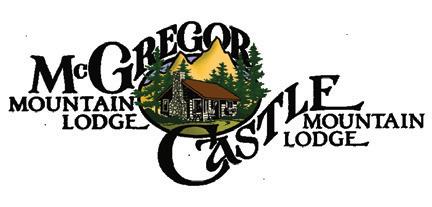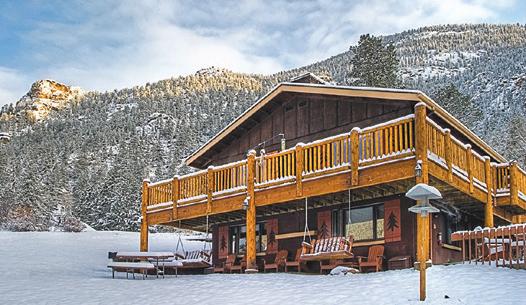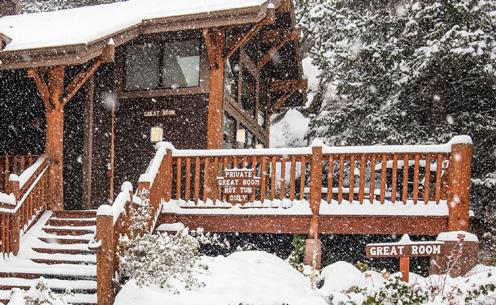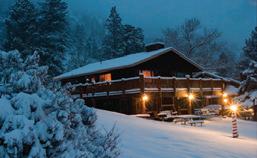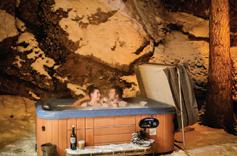
MARCH/APRIL 2022





MARCH/APRIL 2022



MARCH/APRIL 2022






Some 20 different duck species live in Colorado. As this photo essay shows, many of the rarest and most beautiful ducks can be found at lakes and ponds in the major population centers of the Front Range.
Story by Matt Masich
Photographs by Dan Walters
As the magazine celebrates 10 years of exploring life in the Centennial State, we share the saga of how we launched Colorado Life and revisit some of our favorite stories and photos from our first decade.
By Matt Masich
One of Breckenridge’s most colorful characters shares stories of the adventures and misadventures he had in the 1970s during the early days of the ski resort.
By Jeffrey Bergeron
Just north of Garden of the Gods is a spectacular Tudor-style manor house built by Colorado Springs’ founder, Gen. William Jackson Palmer.
Story by Tom Hess
Photographs by Joshua Hardin



An ornately patterned male wood duck rises up in the water and flaps its wings in Littleton’s Ketring Park. Story on page 38. PHOTOGRAPH BY
DAN WALTERS
Craig p 31
Glenwood Springs p 28
Palisade p 25
Saguache p 26 Stories in this issue come from
Bellvue p 10
Estes Park p 33, 57
Grand Lake p 33
Boulder p 12, 27, 58
Nederland p 30
Breckenridge p 42
Lakewood p 11, 29

Cortez p 32
Creede p 62
Durango p 56
Mosca p 28
Wellington p 33
Fort Collins p 31
Greeley p 31
Brighton p 31
Wheat Ridge p 18
Aurora p 60
Denver p 26, 34
Littleton p 18
Genoa p 26
Colorado Springs p 48
Pueblo p 30
Alamosa p 25
San Luis p 29
One-room schoolhouse at Noosa Yoghurt’s Bellvue campus; replica of Coors Field at Lakewood’s All-Star Park; woman walks and photographs every street in Boulder.
Test
musicians.

40 Poetry
Our poets celebrate the peaceful valleys that complement our state’s spectacular Rocky Mountain peaks.
56 Go. See. Do.
Our statewide roundup of the best local festivals, events and daytrip ideas to check out for fun springtime adventures all across Colorado. 60 Colorado Camping
Cherry Creek State Park proves one need not travel all that far to have a rewarding Colorado camping experience. 62 Top Take
A double rainbow arcs across the sky above a rustic barn on a quiet ranch outside the town of Creede.

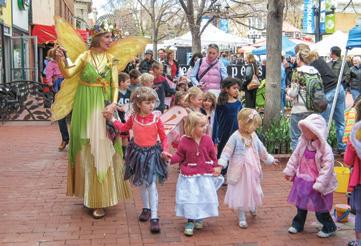


Volume 11, Number 2
Publisher & Executive Editor
Chris Amundson
Associate Publisher
Angela Amundson
Editor Matt Masich
Photo Editor
Joshua Hardin
Design
Traci Laurie, Valerie Mosley, Open Look Creative Team
Advertising Sales
Marilyn Koponen
Subscriptions
Lindsey Schaecher, Janice Sudbeck, Teresa Eichenbrenner
Colorado Life Magazine
PO Box 430 • Timnath, CO 80547 (970) 480-0148 ColoradoLifeMag.com
SUBSCRIBE
Subscriptions are 1-yr (6 issues) for $25 or 2-yrs (12 issues) for $44. Please call, visit ColoradoLifeMag.com or return a subscription card from this issue. For fundraising and corporate rates, call or email subscriptions@coloradolifemag.com.
ADVERTISE
Advertising deadlines are three months prior to publication dates. For rates and position availability, please call or email advertising@coloradolifemag.com.
CONTRIBUTE
Send us your letters, stories, photos and story tips by writing to us, visiting ColoradoLifeMag.com or emailing editor@coloradolifemag.com.
COPYRIGHT
All text, photography and artwork are copyright 2022 by Flagship Publishing Inc. For reprint permission, please call or email publisher@coloradolifemag.com.

THE MAGAZINE YOU hold in your hands is kind of a big deal for the crew at Colorado Life. With this issue, the magazine officially turns 10 years old. I remember exactly where I was 10 years ago: inside a warehouse filled with magazines. Ordinarily, I don’t find warehouses particularly memorable, but this one was for a couple of reasons.
I was there to help Publisher Chris Amundson assemble cardboard displays to promote Colorado Life’s premiere issue on newsstands. This was the last step before the magazine was introduced to the world. It was a big day – but it was about to get even bigger.
While I was fiddling with the displays, I got a call on my primitive, non-smart cellphone. It was my then-wife, Erin, who had some news to share: She was pregnant with our first child, Charlie. I was delirious with joy. When I told Chris the news, he caught some of my delirium and gave me a big hug.
A decade on, both Charlie and Colorado Life are thriving. Charlie is now almost 5 feet tall and wrapping up third grade at the same Denver elementary school my siblings and I attended. Colorado Life is still only 11 inches tall, but it has grown in other ways.
Colorado Life’s first issue went out to our 500 inaugural subscribers. That number has grown significantly every year since – something that probably surprised the handful of naysayers from the early days.
Months before our magazine launched, Apple introduced its Newsstand app, which allowed people to use their iPads to read digital versions of their favorite magazines. As we worked on the debut issue, Chris was approached by a sales rep trying to sell us software to make digital magazines. In the future, the sales rep said, no one is going to read print magazines – everyone will have an iPad and read magazines that way. Chris thought that was ridiculous. Needless to say, he declined the rep’s offer.
Today, Apple Newsstand no longer exists – but Colorado Life most certainly does.
Thankfully, the reports of print media’s death have been greatly exaggerated. True, print newspapers and news magazines have struggled to compete with the internet’s ability to get the news out as soon as it happens. But when it comes to magazines like Colorado Life, there truly is no online competition.
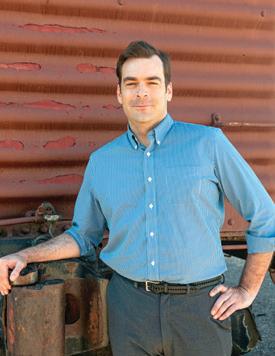
Sitting down to read a glossy paper magazine from cover to cover, as most Colorado Life readers do, is a different experience from reading digital stories on a smartphone newsfeed – as different as sitting down in a theater to watch a movie is from watching three-minute clips of that movie on YouTube.
But the most important difference between the internet and print is this: Most online articles merely convey information, while articles in Colorado Life tell stories. We don’t just want to tout the latest and greatest goings-on in Colorado; we want to share with our readers tales of the people and places that make up the soul of Colorado.
If you turn to page 24, you can revisit some of our favorite stories from our first decade. We’ve done a lot over the past 10 years, but we’re still only getting started.
Throughout it all, our subscribers have made Colorado Life possible. In the years to come, we hope to share our new experiences with even more Coloradans and others who love to explore life in this incredible state.

Matt Masich Editor editor@coloradolifemag.com
Nickel beer in Pueblo
I was delighted to read about the Walter Brewing Co. (“Flavors from the Melting Pot”) in the January/February 2022 issue. My great-grandfather Walter Leslie lived in Pueblo from 1902 to 1950. He must have been a frequent visitor to the Walter Brewery. He left a set of glasses for us to remember that, once upon a time, you could get a glass of beer for 5 cents.
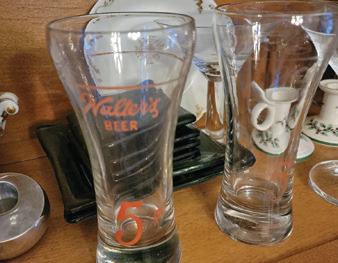
After reading “The Brown Palace” in the November/December 2021 issue, I am resolved to start a tea tradition. We didn’t grow up in Denver, but like many others who call this place home, we “got here as fast as we could” and are raising our girls here. Regular visits to tea can provide anchoring memories for our children along with creating an accessible nature to something fancy.
The kids will marvel at the fascinating facts like the previously rusted front door lock or the super deep well that services the building and become historians themselves. Thank you for unlocking some of these secrets.
Adam and Ashley Espinosa Denver
The November/December 2021 issue of Colorado Life brings back memories! As a native of Colorado, born and raised in Greeley, I frequently read articles about familiar places in Colorado. This issue was no exception. I had just graduated from high school when the Big Thompson Flood occurred (“Colorado Quiz,” November/December 2021).

My husband and I spent our honeymoon at the Brown Palace Hotel in 1979, feeling a little sheepish that we could only afford to purchase burgers at the classy restaurant. And the small bumblebee patches flung at you when dining at the Broadmoor’s Golden Bee adorn my kitchen cabinet as a reminder of the fun evening of entertainment with family (“Flight of the Bumblebee All in Good Fun at the Broadmoor”). Thanks from a true Coloradan.
Joan Nusbaum Colorado Springs
Found
I enjoyed the November/December 2021 issue and always look forward to receiving a new issue. Although I don’t live in Colorado, I am fortunate to have a daughter who does, and I try to visit at least once a year. When she lived in downtown Denver, we would often pass the Brown Palace while walking around, but I have never been inside. The article on the hotel was quite informative.
Ed Leist Bel Air, Maryland
The beauty of your November/December 2021 Roxborough State Park photos provides me with the thrill of a walk while still sitting in my living room chair. I’ve spent many an hour at Roxborough; it is like an old friend. The history that is shared in the article brings a new sense of joy to my future adventures in the park. Colorado Life always does proud for

the new days of exploring that are in our future. When I journey to Puerto Rico, where we have a non-profit, I always take copies of Colorado Life. My friends in Puerto Rico see why I love Colorado.
Howard Waller Littleton
Uncle Frank’s adventures
“John C. Fremont’s Frozen Fourth Expedition” in the November/December 2021 edition was particularly interesting. I feel Fremont, successful in previous expeditions, was blindsided by his new fatherin-law’s ambition and financing of the venture, to achieve a rail route on the 38th parallel through such rugged terrain.
Since the Old Cochetopa Pass had been traversed by animals and native persons for generations, it had been a good goal. Even though the guide was a mountain man, Old Bill Williams’ short cut was to follow Carnero Creek, a non-primary stream, which in short time turned into three stream branches, and they were lost in the most severe of winters. Old Bill apparently didn’t know the directions, and the expedition was doomed.
Twelve years after Fremont, my great-granduncle Francis “Frank” Stahl, at 20 years old, was also exploring this region with friends. After developing a gold claim in Central City, they came back to Denver, to Pueblo, crossed the toll bridge and headed to the San Luis Valley over La Veta Pass. He described in his autobiography meeting Kit Carson there near Fort Garland. Frank and friends were heading for the gold rush
in the San Juan Mountains. But after many trials and tribulations in the San Luis Valley, he headed back home to the Topeka area, enrolled in the Union army and continued a very full life.
Eric Talla Glenpool, Oklahoma
Key that opens Colorado
I have found great joy in reading Colorado Life. The stories and pictures are incredible. I always enjoy the trivia questions and try to see who gets more correct, me or my husband. In the November/December 2021 issue, the story of John C. Fremont was so interesting. I also really enjoy the recipes for German cabbage buns (“Cabbage Classics,” November/December 2021). I love them and get them in Brighton at Lauer-Krauts. In earlier issues, I have found and noted places I want to visit eventually. Our state has so much to see and do. In October, my husband and I took a weeklong “adventure” traveling over six mountain passes, seeing magnificent groves of golden aspen, and visited eight ghost towns. Colorado has the best, and Colorado Life opens it up for us.
Nancy Boehme Broomfield
As true now as ever
My husband and I have been fans of Colorado Life for many years. I look forward to being reminded of why Colorado is such a special place to live.
The article about Nick and Helen Forster and eTown Hall lit up the nostalgia circuits like fireworks (“Broadcasting from Boulder to the World,” November/December 2021). We started attending eTown performances in 1999. In those days, we followed Helen Forster’s cues to applaud or re-record wonky segments. It was really fun to
be part of the show. Even before that, we loved to see Hot Rize, Red Knuckles and The Trailblazers at the Niwot Grange Hall where the stomping, raucous audience shook the old plank walls.
We really appreciate Colorado Life’s eclectic mix of state history, natural history, entertainment, events and attractions, both natural and man-made. My heart warms and a smile spreads across my face whenever I can say, “I’ve been there, I’ve seen that,” or, “We need to go there, we need to see that.” For many years, the masthead of The Denver Post read, “ ’Tis a Privilege to Live in Colorado.” Colorado Life reminds us why this is as true now as it ever was.
Cindy Maynard Longmont
It will last longer I have enjoyed Colorado Life for about eight years. My longtime friend got me a subscription for my birthday, and I have been hooked ever since. The September/ October 2021 article “Portable Petroglyphs Help Preserve the Originals” I found so very interesting.
My husband and I do a lot of camping. We recently found a place 40 minutes from home to spend a few days. We hiked in an area where we found many pottery shards. Of course, your inclination is to pick them up and take them home for souvenirs, and many people do, but the thing to do is take a picture – that will last forever.
I am sure someone will undoubtedly be walking in that same place and run across the shards I left behind. I can only hope they will feel respect for the culture of the Native Americans and take a picture, too.
Glenda Griffin Cortez
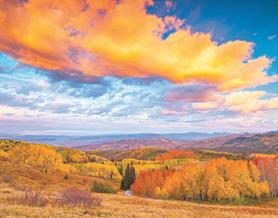


Explore Colorado with the new 2022 Colorado Life wall calendar! It has the gorgeous photography you love in the magazine, ready to hang in your home or office.
Order before they’re gone!
SEND US YOUR LETTERS
We can’t wait to receive more correspondence from our readers! Send us your letters and emails by April 1, 2021, to be published in the May/June 2022 issue. One lucky reader selected at random will receive a free 1-year subscription renewal. This issue’s winner is Nancy Boehme of Broomfield. Email editor@ coloradolifemag.com or write by mail to PO Box 430, Timnath, CO 80547. Thanks for reading and subscribing!
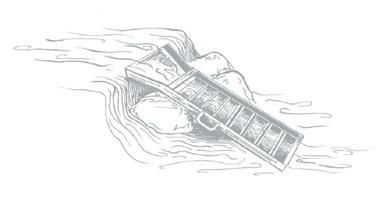

Pleasant Valley Schoolhouse No. 7 is the last one-room stone schoolhouse in Larimer County. It is being revitalized by the family that co-founded Noosa Yoghurt.
Rare schoolhouse restored on Noosa Yoghurt’s Larimer County campus
by ETHAN GANNETT
There is no bell in the belfry of Pleasant Valley Schoolhouse No. 7 in rural Bellvue. That the school and its belfry exist at all is surprising, considering it last held classes more than 100 years ago. In fact, it is Larimer County’s last remaining one-room stone schoolhouse.
The restored Pleasant Valley Schoolhouse is nestled to the side of a verdant field on the estate of Morning Fresh Dairy and Noosa Yoghurt. A wooden rolltop map case adorns the corner of the 24-by38-foot classroom, which is filled with student chairs of all grade levels. A recital chair sits at the front of the room, seemingly ready for the next nervous student to step up.
The stone schoolhouse was built in 1879 to teach the children of local farmers and ranchers. Prominent Fort Collins businessman Abner Loomis gathered the community to build the school from lo-

cally quarried sandstone after the previous wooden schoolhouse burned down. When the stone schoolhouse closed in 1913, the building reverted to the Graves family, who owned the land.
The Graves family is descended from William Charles Graves Sr., whose son went to school here. And that little boy’s descendant, Robert Graves, is the current owner of Morning Fresh Dairy and the co-founder of Noosa Yoghurt. Five generations of the family have run this dairy farm since 1894.
Sherry Graves, Robert’s mother, did the work to get the schoolhouse listed on the National Register of Historic Places in 2003 and is now seeking to outfit it with period furniture.
Lori Graves, her daughter-in-law, led the contractors during the restoration, which required work on the schoolhouse’s foundation and original stone, a new inte-
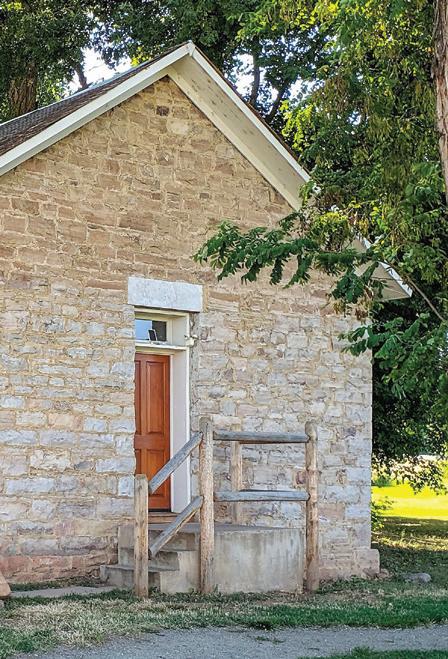
rior wood floor and even horsehair plaster walls.
When asked about the next steps of the restorations, Lori said, “The list is long, and the day is short.” Sherry’s next priority is finding someone with a period schoolmarm’s desk they would be willing to donate to complete the schoolroom furnishing.
There is also the matter of the school’s missing bell, which was donated to a local church many years ago. Sherry and Lori are working with church leaders to see if they will trade it back, putting the finishing touch on a restoration decades in the making.
Tours of Pleasant Valley Schoolhouse No. 7 are included as part of regularly scheduled Morning Fresh Dairy farm tours. Call (970) 482-5789 for tour information.

by LEAH M. CHARNEY
Driving on West Alameda Avenue in Lakewood might elicit a double take. Is that …? It can’t be! But it is: a carbon copy of Coors Field, home of the Colorado Rockies baseball team.
The miniature field, 90 percent the scale of the original but with far less seating capacity, opened as Coca-Cola All-Star Park in 1998. Built in conjunction with the Rockies and Major League Baseball, the venue’s creation was part of festivities surrounding the 1998 All-Star Game in Denver. The league donates annually to community programs in each city where All-Star games are held. That year, it partnered with the Gold Crown Foundation, a nonprofit athletic organization serving Colorado youth, resulting in the replica of the existing stadium.
The space was renamed Keli McGregor Field at Coca-Cola All-Star Park in 2011, honoring late Colorado Rockies President Keli McGregor, who died unexpectedly the previous year at age 48. The park continues to be used by young people throughout the region, hosting the Colorado High School Athletic Association’s yearly baseball playoffs and serving as home field for Colorado Christian University’s baseball team. It is also home to “Eye on the Ball,” an oversized, reflective, baseball-shaped sculpture that visitors are encouraged to take photos with.
Though no professional games have ever been played at the field, no detail was overlooked in its design: It has the same “LoDo green” metal awnings and gates as Coors Field; the same rows of red bricks course around the building and clocktower; even columbines, the state flower, adorn tiles perched at the tops of columns, as they do at the big-league park. The same architectural firm that built Coors Field created the miniature version, too.
“The one thing people don’t notice – on Coors Field, I’m not sure people notice them, either – are the columbines,” said Tom Quinn, executive director of Alameda Connects, the business district that surrounds the field. “I didn’t notice them for a year or two and then was like, ‘Why didn’t I ever see those before?!’ ”
People can see for themselves – and take a selfie – at the intersection of West Alameda Avenue and South Harlan Street.

Photographer walks each and every city street to reveal the magic of daily life
by MATT MASICH
Karen Jacot was in a rut. Restless from being cooped up in her Boulder home during the early days of the pandemic, she decided to take a walk through her neighborhood. Jacot enjoyed it so much that she decided to go on a walk every morning, taking a different route each time. She didn’t start out with the intention of walking every single street in Boulder, but












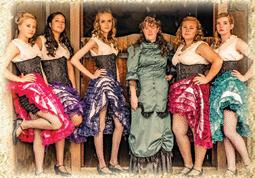

some 10 months and 955 city streets later, that’s exactly what she had done. And because Jacot brought her camera on each walk, she came away with thousands of photos chronicling her one-woman walking tour of Boulder.
The best of Jacot’s images are collected in the new photo book Rabbits in Driveway Taken together, these photos form a vivid portrait of Boulder in all its quirky beauty.
The first thing she noticed on her walks were creative mailboxes, including several with inspirational quotes that the homeowners changed regularly. But the mailboxes were only the beginning. One day, she spotted an impressively tall pyramid made of electric irons and topped with antlers in someone’s yard. Another walk took her past a hedge trimmed into the shape of a sports car, complete with real tires and hubcaps.
even mention what neighborhood they are from, because much of the fun lies in the chance discovery.

Other than a brief introduction to start the book, the photos are presented without captions or commentary; the images themselves tell the story. Jacot made a conscious decision not to include photo locations or
“It’s not about this one ‘cool thing’ that is out there,” she writes, “but about all the bits and pieces that collectively make up one unique city.”
Among those bits and pieces are the red rock Flatirons, ornate Victorian homes, murals, pets peering from windows, as well as many notes and signs, often bearing rather unusual messages.
The meaning of some signs is easily discerned, such as the note affixed to a tree branch reading, “Plz eat delicious plums as you walk by!” Less clear is the purpose of the note tied to another tree branch, which says, “I wish my dog could talk.”
A sign on a telephone pole offers the professional services of a “Dog for Hire” – a pooch that “answers to Bonnie but could act under names such as Ronny, Lonnie or Donny.” And then there’s the sign that gives the book its title – a professionally printed sign that gives all passersby the warning, “Caution: Rabbits in Driveway.”

Bird watchers are finding their perfect playground on the Pioneering Plains of northeast Colorado. The natural backdrop of Plains areas in Sterling and Logan County invites birders to journey off the beaten track in search of new encounters with a variety of species in an unspoiled environment.
Did you know there are more than 300 species of birds in this area?









Award-winning documentaries and visitor information about Estes Park, Colorado and Rocky Mountain National Park. Start your free trial now!














































































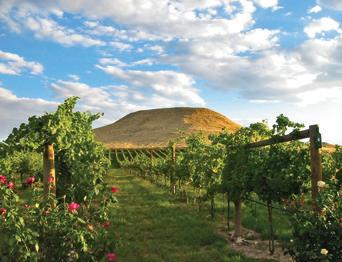






Test your knowledge of the state’s musical greats. by BEN KITCHEN
Colorado grown. Colorado crafted. Eat and drink local at Snowy Peaks Winery.






SNOWY PEAKS WINERY






From locally-made cheeses and charcuterie to smallbatch, hand-crafted Colorado wine, we’ve got your Colorado fix in our Estes Park tasting room. Support local. Drink Colorado! UNAPOLOGETICALLY



















292 MORAINE AVE • ESTES PARK SNOWYPEAKSWINERY.COM • 970.586.2099







Visit Summit County’s Enchanting B&B






Experience historic charm at the Frisco Lodge. Our exceptional hospitality, après ski, soup bar, romantic courtyard with outdoor fireplace and hot tub are just a few reasons our guests rated us the #1 bed & breakfast in Frisco and all of Summit County!
See why our guests think we are the best: http://bit.ly/FriscoLodgeReviews
1According to Billboard, the 10th-biggest single of the 2000s was Timbaland’s remix of the song “Apologize,” originally by what pop rock band from Colorado Springs?
2 Deborah, Carla, Mary and Susan are just 9 percent of the title characters of what song, by far the most successful by Boulder-founded group The Nails?
3
While at Denver East High School, Philip Bailey, Larry Dunn and Andrew Woolfolk played together in Friends & Love. By 1973, they were all members of what Rock and Roll Hall of Fame funk band whose name is also a list of things?
4 In 2004, Western Slope act the String Cheese Incident was slated to become the first jam band ever to perform at what massive Chicago music festival?
www.friscolodge.com 800-279-6000
321 Main St | Frisco, CO 80443
5 What Denver band, which hit No. 3 on the charts with “GreenEyed Lady” in 1970, is named after a delicious-sounding mountain in Boulder County?

MULTIPLE CHOICE
6
What Denver-based band, whose name is a Russian word meaning “girl,” is perhaps best known for contributing 10 songs to the Little Miss Sunshine soundtrack?
a. BaBushKa
b. DeVotchKa
c. ZhenShchiNa
7
“Rocky Mountain High” may be one of Colorado’s official state songs, but its writer, John Denver, was born in what other Four Corners state?
a. Arizona
b. New Mexico
c. Utah
8
While the 2008 Democratic National Convention was held in Denver, only one musical act performing at the event hailed from Colorado. Which one?
a. Big Head Todd and the Monsters
b. Colorado Springs Philharmonic
c. Yonder Mountain String Band
9
Which of the following historymaking women lends her name to a 2016 album by Denver band The Lumineers?
a. Cleopatra
b. Joan of Arc
c. Amelia Earhart
10
Of the following area codes for the Denver metro region, which one inspired the name of the electronic music duo whose Top 10 singles include “Don’t Trust Me” and “My First Kiss”?
a. 303
b. 720
c. 983

11
Even though it’s a location and not a musician, Red Rocks Amphitheatre is enshrined in the Colorado Music Hall of Fame.
12
Conifer-born Trey Parker won an Academy Award for writing “Blame Canada” for the South Park: Bigger, Longer & Uncut soundtrack.
13
In 2008, Denver singer Jill Sobule sued Katy Perry over musical similarities between Perry’s “I Kissed a Girl” and Sobule’s 1995 single “I Kissed a Girl.”
14
Lamar’s own Ken Curtis briefly replaced Frank Sinatra as the Tommy Dorsey Orchestra’s singer.
15
Denver’s Kip Winger, frontman of rock band Winger, was nominated for a Grammy for Best Contemporary Classical Composition.
No peeking, answers on page 61.

Colorado has a surprising variety of colorful duck species –even in the middle of the city

by MATT MASICH photographs by DAN WALTERS
THE DUCK PONDS found in towns across Colorado are not as peaceful as they might first seem. For the ducks who live there, the scene is fraught with life-and-death struggles – and at water’s edge, photographing the action from a duck’s-eye-view, is nature photographer Dan Walters.

Common goldeneyes make a whistling sound as they swiftly fly in for a landing at

He stands on the shore of Kountze Lake in Belmar Park, near his home in Lakewood, to watch the ducks known as common mergansers working hard for their daily meals.
Mergansers are diving ducks that completely disappear beneath the surface of the lake for up to 30 seconds in search of food. At Kountze Lake, that food is often crayfish, also known as crawdads. When the merganser surfaces from its dive, it clutches a crayfish in its long, hooked bill, the pint-sized crustacean’s legs wriggling helplessly in the air.
“They shake the crayfish until its claws and legs fall off,” Walters said. “Then they swallow them whole and dive down to find another one. It’s amazing how many they can eat.”


To capture images of mergansers hunting crayfish and other action shots, Walters relies on skills he honed while training for a career as a sports photographer. That was the path he envisioned until the day he took an impromptu trip to the top of Mount Evans to test out a new camera lens by photographing the baby mountain goats at the summit.
Walters enjoyed wildlife photography so much that he decided to make that his focus. But as cute as baby mountain goats are, he soon gravitated to photographing birds, as the variety of bird species in Colorado is vastly greater than mammal species. “You get so many different seasons, with so many different birds flying in and out of our state, there’s always something to photograph,” he said.
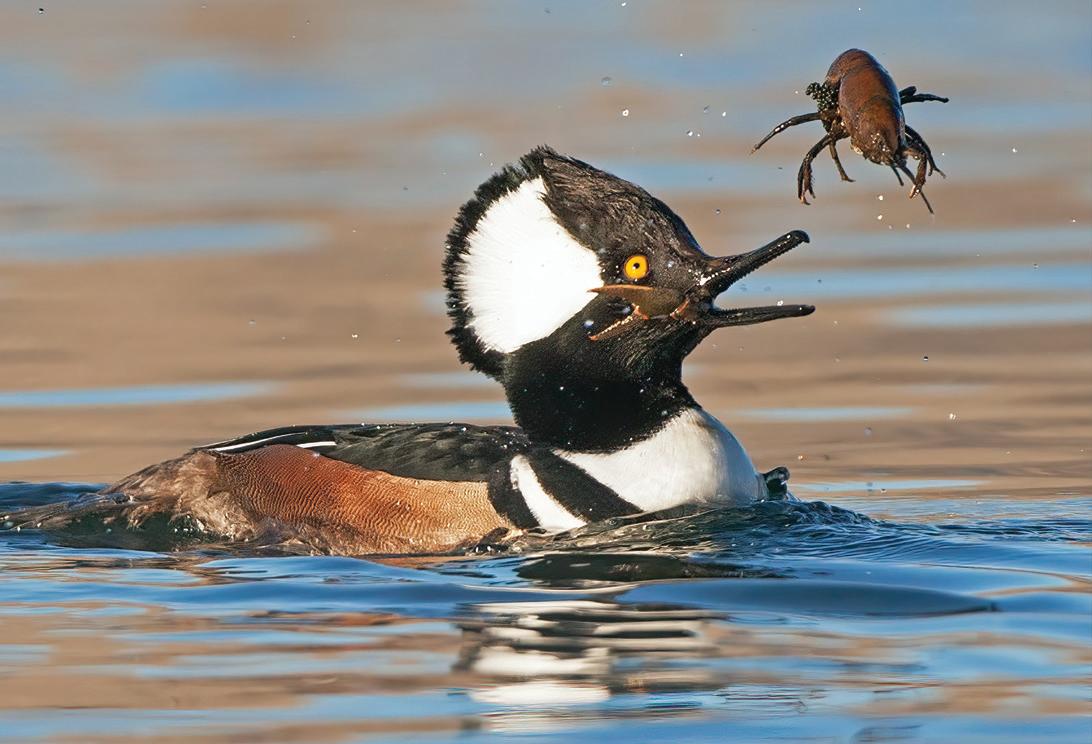
That variety includes ducks. For Coloradans only familiar with mallards, whose males have distinctive green heads, it may come as a surprise that there are at least 20 duck species that spend a significant part of the year in Colorado. March and April are great times to find ducks before certain species continue their migrations elsewhere.
The two main types of ducks are divers and dabblers. Divers, such as the mergansers, go underwater to search for food. Dabblers, which include mallards, mill about on the surface, grazing for whatever plants or insects they find.
Some of the more unusual duck species are often hidden in plain sight, nesting alongside the far more numerous mallards in lakes and ponds near the state’s major population centers. Besides Belmar Park, Walters’ favorite duck spot on the west side of the Denver metro area is Prospect Park in Wheat Ridge. Many types of ducks can be found there, and though they are wild, they are accustomed enough to humans to not be too skittish.

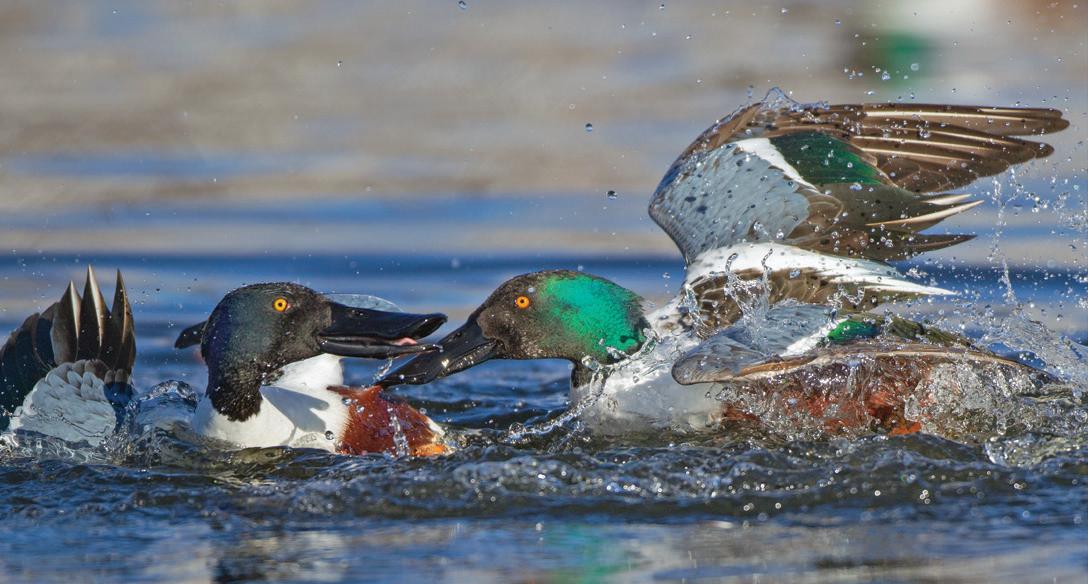


Still, Walters has to take care not to frighten off the ducks before he can take their picture. When photographing diving ducks, he will wait for them to dive, then move closer while they are submerged. He repeats the process until he has scooted up to the shore, where he gets as close to the water’s surface as possible to get on the same level as the ducks.
When most of the lake is frozen, there is often a small patch of open water near the shore where the various duck species congregate, making it easier to photograph many species within a short span. As spring progresses, some species fly north. However, this corresponds with another influx from the south, as snowy egrets, white pelicans and other warm-weather birds move into the ducks’ splashing grounds for the next round of Colorado’s year-round avian extravaganza.

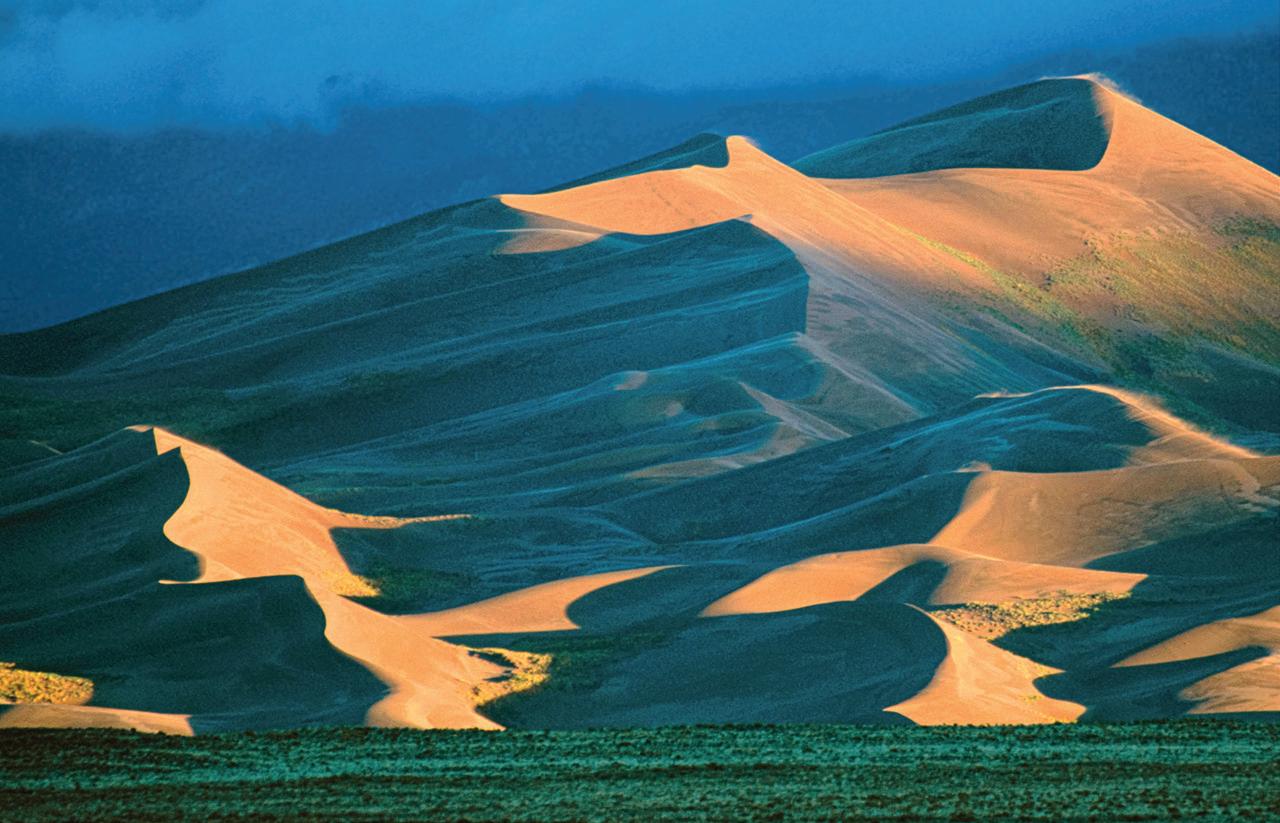
by MATT MASICH
THE PREMIERE ISSUE of Colorado Life Magazine rolled off the press in April 2012. In the 10 years since then, our adventurous crew of writers and photographers has logged tens of thousands of miles traveling the state to bring our readers stories about the people and places that make Colorado, Colorado.
WE ARE ABLE to do what we do thanks to the loyal support of our subscribers and advertisers, without whom Colorado Life would not have made it 10 weeks, let alone 10 years.
This publication exists because we believe a state as fascinating as ours deserves a magazine that explores its culture, natural wonders and history. When Colorado Life founders Chris and Angela Amundson searched for such a magazine more than 10 years ago years ago, they discovered there wasn’t one – so they created this magazine.
The Amundsons started out in the magazine business in Norfolk, Nebraska, as owners and publishers of Nebraska Life However, they often found their hearts were in Colorado.
Angela grew up spending summers in Estes Park, staying in her Aunt Lucretia’s cabin on land that’s now part of Rocky Mountain National Park. When Chris, a
former ag pilot, bought a Maule singleengine airplane in 2011, he, Angela and their three small children would fly to Colorado for weekends in Estes Park.
“After a summer of doing that,” Chris said, “it got to be that all we could talk about was going to Colorado and exploring.”
One Sunday afternoon, as the Amundsons prepared to fly back to Nebraska, the family stopped into Macdonald Book Shop on Estes Park’s Elkhorn Avenue. As Angela and the kids headed back to browse the books, Chris stayed up front looking for magazines about Colorado. He found there were plenty of ski magazines and a fine wildlife magazine, but nothing about the life, culture and history of the state.
“That moment planted the seed that maybe we should do a magazine for Colorado,” Chris said. “We began to talk about it on the way home and even prayed about
it that night.”
Back in Nebraska the next day, Chris called his friend Mike Flori at Kent News, a distributor to newsstands in both Nebraska and Colorado, to see how hard it would be to start selling a new magazine on Colorado newsstands. Not too hard at all, as it turned out.
Chris next called Boulder nature writer and wildlife consultant Stephen R. Jones, whom he had met when Jones gave an eco-tourism talk at a regional travel conference, to get recommendations for Colorado freelance writers and photographers. At the top of his list were photographers Wendy Shattil and Bob Rozinski, who sent Chris their recent photo book on Great Sand Dunes National Park and Preserve. Chris was so impressed with their images that he instantly knew he wanted to feature the Great Sand Dunes in the first issue of Colorado Life
The new magazine’s mission and
logistical infrastructure was in place. All that remained was to find a staff to bring Colorado Life to life. After a statewide search spanning several months, Amundsons hired three experienced journalists from across Colorado: Joshua Hardin of Loveland, Matt Masich of Denver and Nathan Ward of Salida.
The new staff met each other for the first time on March 1, 2012, in a meeting room at the Estes Valley Library. Over the course of a few hours, they pitched dozens of story ideas that would fill the pages of the magazine’s first year and beyond. Just two months after that first meeting, Colorado Life debuted with the May/June 2012 issue. Around the same time, the Amundson family moved to Colorado for good.
Two of the three inaugural staff members who helped launch the magazine are still on the staff today – Hardin as photo editor, and Masich as editor. And we are proud to say that many of Colorado Life’s 500 inaugural subscribers have faithfully renewed their subscriptions every year up to the present – and we are grateful that many thousands of subscribers have joined them over the years.
To celebrate Colorado Life’s first decade, we are revisiting some of our favorite stories we’ve done in the past 10 years. As we look back, we are filled with excitement about all the new adventures we’ll undertake in the decade yet to come as we continue our mission to bring you the best Colorado has to offer.
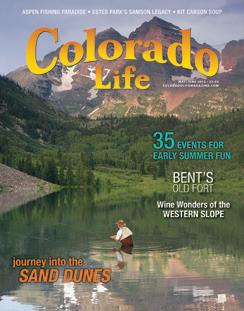
May/June 2012
As we prepared to launch Colorado Life, it was important that our first feature story make a statement about both the state and the magazine. By featuring Great Sand Dunes National Park and Preserve, we highlighted two things that define Colorado: its natural beauty and its knack for defying expectations.
For many visitors, gazing at this seemingly Saharan scene against a backdrop of snowcapped, 14,000-foot Rocky Mountain peaks is downright mind-blowing.

“The dunes look otherworldly, something only millions of years of persistent wind can create,” staff writer Nathan Ward wrote. “From up high, there is little sign that humanity exists, just sand, high mountains and the hazy, wide San Luis Valley.”
Ward reflected on the journey of untold millennia each grain of sand had taken as it was picked up by the wind and blown across the valley, finally being trapped against a natural pocket of the Sangre de Cristo Mountains, 25 miles northeast of Alamosa.
“This dune land can provide a lifetime of experiences for us,” he wrote, “but this is geologic time, and each grain of sand will outlast everything we know.”
May/June 2012
The next feature in Colorado Life’s premiere issue ventured across the Continental Divide from the Great Sand Dunes to the Western Slope on a jaunt to Colorado’s wine country.
Grand Valley wineries are known for their world-class wines made from grapes grown in the scenic vineyards surrounding the town of Palisade. However, traditional grape wines weren’t the object of our pursuit for this story – we were searching for something more distinctly Colorado.
“We found it with an elixir made from the fruit that gave the Western Slope its sweet reputation before that saucy wine arrived,” we wrote. “The search led to Carlson Vineyards, a winery rumored to make some of the best peach and cherry wines in the state.”
Founder Parker Carlson first poured us wine he made from tart Montmorency cherries. “It’s been called ‘cherry pie in a
Great Sand Dunes National Park and Preserve near Alamosa is the site of North America’s tallest sand dunes. Carlson Vineyards founder Parker Carlson tends to his wine grapes.
glass’ by some,” we wrote, “but Parker simply calls it ‘the fastest dessert in the world.’ ” Our assessment of the delicately sweet Palisade peach wine was even simpler –we deemed it “liquid gold.”
Colorado’s wine industry has thrived in the decade since our story appeared. The number of wineries statewide has increased from 96 to 154, while total production has more than doubled, jumping from 1.5 million to more than 3.1 million bottles annually.
September/October 2012
Tales from Colorado’s colorful history have always been as much a part of the magazine as stories about nature and travel. Our story on the Smaldone family wove the saga of the Italian American clan that ran organized crime in Denver for much of the 20th century.
Led by brothers Clyde and Checkers Smaldone, the family oversaw bootlegging and gambling rackets from their headquarters at their North Denver restaurant, Gaetano’s.
“Depending on whom you talk to, they were either modern-day Robin Hoods or shoot-’em-up Mafiosi straight out of a gangster flick,” we wrote. “In reality, they were neither.”
The Smaldones looked after their community, making sure no one in North Denver went hungry. Still, they made their living by breaking the law, and those who crossed them sometimes died violent deaths. Such was the fate of former University of Colorado football player Skip LaGuardia; in 1973, he started his own illegal gambling racket in competition with the Smaldones, only to be murdered in front of his Denver home with a shotgun blast to the face.
To their credit, the Smaldone elders forbade their children from joining the family crime business, and by the 1980s, their criminal enterprise ceased to exist. However, Gaetano’s restaurant remains in business, and though the family sold it in 2006, it carries on the Smaldone legacy in North Denver.
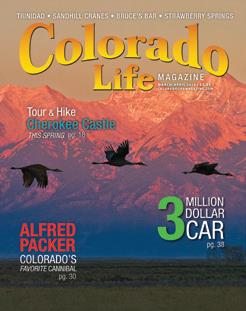
March/April 2013
Alfred G. Packer had five companions when he set out to cross the San Juan Mountains in the brutal winter of 1874. When he reached the other side two months later, he was alone.
Upon arriving in Saguache, Packer claimed his comrades left him behind in a blizzard. But if that was so, why hadn’t the others emerged from the mountains before him? For that matter, why was Packer, who was penniless when he started his journey, now spending extravagant sums? Something didn’t add up.
Investigator Charles Adams was blunt when questioning Packer, stating he believed the other men were dead, and that Packer knew something about it. “You might as well tell the truth,” he said. “If the matter is as I suspect, you are more to be pitied than blamed.”
Minutes passed before Packer broke his silence with a cryptic, disturbing observation: “It would not be the first time that people had been obliged to eat each other when they were hungry.”
Packer admitted that the others had died and that, facing starvation, he had eaten parts of their corpses. Prosecutors convicted him of killing all five of his companions, yet Packer maintained one of the other men, Shannon Wilson Bell, had been the murderer, and that he had only killed Bell in self-defense. Modern forensic analysis suggests Packer was telling the truth.

Though demonized in his own day, Packer has since become something of a folk hero, earning the dubious distinction of being Colorado’s favorite cannibal.
May/June 2013
There’s a good reason why the six-story structure in the Eastern Plains town of Genoa is known as the World’s Wonder View Tower: On a clear day, a person can see six states from the top. In theory, anyway.
Though witnessing this view was the ostensible purpose of Colorado Life’s 2013 visit to this I-70 roadside attraction, we found the quirky museum at the base of the tower to be far more interesting.
“’Museum’ is one way to describe the 20-room complex inside this long, stone

building,” we wrote. “ ‘Gargantuan offspring of a haunted house and the world’s strangest antique store’ is another, more accurate description.”
Greeting visitors at the museum entrance was Jerry Chubbuck, the tower’s whimsical, perpetually smiling 82-yearold proprietor. He ushered us in to show off an assortment of artifacts that was as large as it was bizarre. Displays included petrified dinosaur poop, rooster eyeglasses and a 2-foot-long Inuit war club made from what he politely called “the part of the walrus that the mama walrus doesn’t have.”
Chubbuck, who had owned and lived in the tower since the 1960s, died two months after our story was published. Nearly all his collection was auctioned off, and the empty tower was sold. But this historic tourist trap may have a second life – it is now owned by nonprofit group See Six States, which is in the process of renovating and restoring the tower.
Jerry Chubbuck shows off a rifle that was part of the vast collection he kept at the World’s Wonder View Tower in Genoa. A pressed penny is a souvenir from a trip to the top of Pikes Peak.
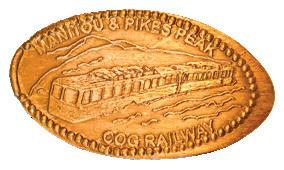
July/August 2013
Many Coloradans live near major tourist attractions they have never visited; they mean to go someday but just never get around to it. Colorado Life Editor Matt Masich was in that category – until he got hooked on penny press machines.
Typically located at popular tourist spots, these machines allow people to create cheap souvenirs. Just insert two quarters and one penny, turn a crank, and out pops a squished, elongated penny with a design pressed into it.
When Masich decided to visit every penny machine within a day’s drive of Denver, the pursuit led him to take his first trips to the Butterfly Pavilion, Coors Brewery, Garden of the Gods and many more remarkable places. His favorite was the top of Pikes Peak.
“As advertised in ‘America the Beautiful,’ the view included spacious skies and amber waves of grain, though the mountains seemed more blue than purple,” Masich wrote. “Maybe we came at the wrong time of day.”
He squished souvenir pennies with designs reading “Pikes Peak Summit.”
“After all,” he wrote, “what was the point of coming all this way if we couldn’t prove, in penny form, that we were there?”
There were penny machines at 80 locations across Colorado in 2013. Today, that figure is closer to 125.

May/June 2014
Bits of white, paperlike ash fell on Steve and Dee Spencer as they sat down to eat sandwiches in their backyard west of Boulder on Labor Day 2010. At their home in Sunshine Canyon, the sun was quickly being blotted out by a wall of smoke rising beyond the next ridge.
Soon, the Fourmile Fire destroyed the home in which the Spencers had raised their two boys. This happened as they were preparing for their son Noah’s wedding, just two weeks away.
“At this point, everything could have fallen apart for the Spencers,” we wrote. “Instead, everything seemed to fall perfectly into place. Noah’s fiancee’s mother gave them a place to stay in Boulder; one of their friends lodged visiting family members at his house; and another friend hosted the rehearsal dinner. As loved ones gathered in the wake of calamity, the emotional highs of the Sept. 18 wedding seemed even higher.”
Four years later, the Spencers sat in the same backyard in the same lawn chairs, which miraculously survived the fire, but with a new house. They decided to rebuild because there simply was nowhere else they wanted to live. Many of their neighbors did the same.
“You can rebuild a house, but how do you reknit a community?” Dee Spencer said. “It’s a real community. That’s why we came back.”
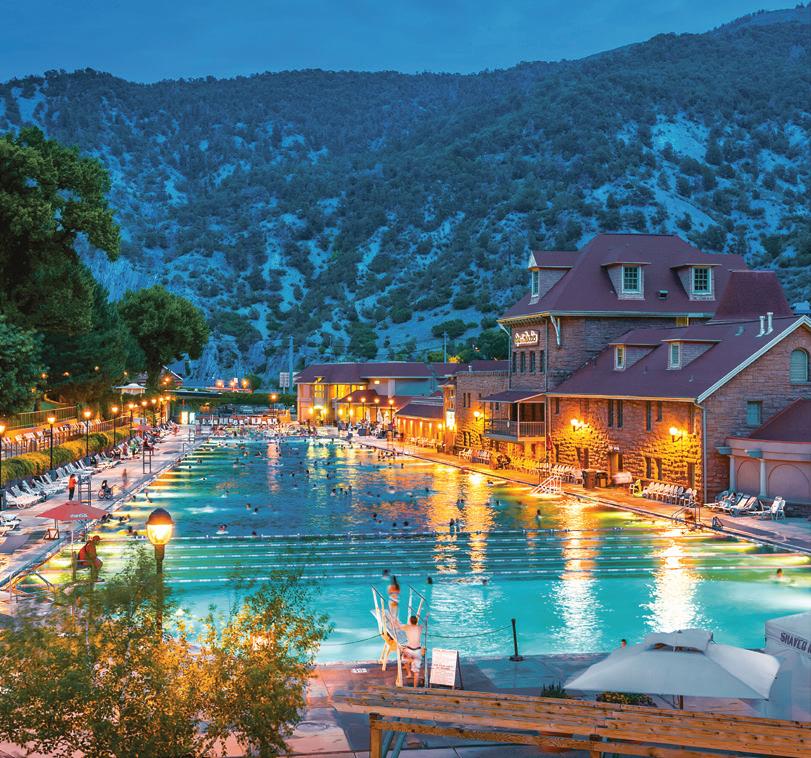
Measuring 405 feet long and 100 feet wide at its widest point, the pool at Glenwood Hot Springs Resort is the world’s largest mineral hot springs pool.
For the rich and famous of more than a century ago – including President Theodore Roosevelt and the unsinkable Margaret “Molly” Brown – a trip to the hot springs at Glenwood Springs was a posh getaway.
These days, their jet-setting modern equivalents have migrated 40 miles up the Roaring Fork Valley to Aspen. Meanwhile, Glenwood Springs ditched the glitz to become a small, welcoming mountain town that just so happens to be an all-season resort destination.
Utes frequented the springs for generations, prizing the waters for their healing properties; they named the springs Yampah, or “big medicine.” Later settlers also sought health benefits from the springs and the related Yampah Vapor
Caves; famed gunslinger Doc Holliday came to the caves in 1887 to treat his tuberculosis but succumbed a few months later and was buried in Glenwood Springs.
The 124-degree hot springs originally emerged in the Colorado River, which flows through town. In 1888, mining magnate Walter Devereux hired local jail inmates and other laborers to build a stone wall to divert the river so the springs would bubble up on land he owned. To serve the high-end clientele flocking to his new hot springs pool, Devereux built the Hotel Colorado.
While the hotel and two-block-long hot springs pool remain focal points for visitors, rafting, hiking and other outdoor pursuits are almost as popular. One of the best-loved pastimes is hiking the 1.5-mile trail to Hanging Lake. Mudslides last year destroyed the trail but spared the lake and its spectacular waterfall; officials hope to reopen the trail sometime this summer.

With the high peaks of the Sangre de Cristos soaring in the background, the town of Mosca seems an unusual spot for an alligator farm. Then again, Colorado Gators Reptile Park specializes in the unusual.
“Jay Young lives on a farm in the San Luis Valley with his wife, two daughters and 300 alligators,” we wrote. “Young has spent two decades caring for the alligators, and they show their gratitude by trying to eat him. It’s nothing personal – it’s just what gators do.”
Colorado Gators started as the Young family’s tilapia farm, where fish thrived thanks to the site’s geothermal well. Jay’s parents brought in 100 baby alligators to serve as living garbage disposals for dead fish. As the gators grew, people started showing up just to see them.
Jay Young started wrestling gators by necessity when moving them from one pond to another. He eventually got good enough to start offering lessons – though he incurred numerous gator chomps in the course of acquiring that expertise. A visitor who witnessed one particularly nasty bite ran to the gift shop to inform Jay’s mother.
“Your son just got bitten by a big alligator,” the terrified visitor said.
“Serves him right,” his mother deadpanned.
In addition to raising their own gators, the Youngs now offer sanctuary to other folks’ pet alligators that have grown too big for them to handle, as well as all manner of other dangerous reptiles.
September/October 2015
The words “Oldest town in Colo.” are spelled out in white-washed stones on the sage-dotted mesa overlooking San Luis. Founded in 1851, just three years after Mexico ceded this land the United States, the town is also home to the state’s oldest continuously operating business, the R&R Market, which opened in 1857.
“Even the way people speak is tied to the distant past,” we wrote. “Many in San
Luis grew up speaking a dialect of Spanish that is closer to the language of the Spanish conquistadors than it is to the language of present-day Mexico, though a hybrid form of Spanglish has become more common.”
A high proportion of residents are descended from colonial Spanish families that settled the San Luis Valley as early as 1598. For centuries, they lived in isolation, developing their own unique culture. Many people here are blood relatives, and those who aren’t often feel they are anyway. When families lose a loved one, community members come together to prepare a massive banquet for mourners after the funeral.
“We grow up together, go to school together, live amongst each other, see each other on a daily basis,” said Donna Madrid, who volunteers to prepare meals for the bereaved. “You’re basically like family.”

La Capilla de Todos los Santos, Spanish for “Chapel of All Saints,” sits at the top of the mesa overlooking San Luis. The town is the oldest in Colorado, founded in 1851; though the adobe chapel was done in the old Spanish style, it was built in 1986.

Few Colorado institutions are as bizarre, and as well-loved by Coloradans, as Lakewood restaurant Casa Bonita.
“With an incongruity seldom found outside the realm of dreams, a pink Spanish colonial edifice rises up from a strip mall on Colfax Avenue,” we wrote. “This is Casa Bonita, a Mexican restaurant that has been making the surreal real since 1974.”
The cavernous interior is even more unusual, filled with a jumble of architecture that gives the appearance of several Mexican villages crammed next to and on top of each other. Everything centers around an indoor lagoon and waterfall, complete with a 30-foot cliff from which Acapulco-style cliff divers plunge for patrons’ entertainment every 15 minutes.
Though Casa Bonita has been locally famous since it opened, it was introduced to a worldwide audience after it was featured in a 2003 episode of South Park. Because the restaurant seemed so fantastical, viewers outside Colorado assumed it was purely fictional; when they found out it was real, many embarked on pilgrimages to experience it in person.
When the pandemic forced Casa Bonita’s closure, its fans launched a movement to save it. Last year, South Park creators Trey Parker and Matt Stone purchased the restaurant and plan to reopen it soon.
September/October 2016
Puebloans’ pride in their hometown chiles is indistinguishable from their pride in Pueblo itself. They don’t even need to see, smell or taste a thing to know Pueblo chiles are being roasted nearby – they start to salivate the moment they hear a chile roaster’s gas flames ignite. Pueblo chiles form the backbone of the dish known as pork green chile, an increasingly popular staple of Colorado cuisine.
“Every restaurant in Pueblo serves green chile,” fourth-generation chile grower Carl Musso said. “If they don’t, they don’t stay in business.”
The local peppers are celebrated at the Pueblo Chile & Frijoles Festival each Sep-
tember. Still, Hatch chiles from New Mexico used to dominate the market in Colorado. However, by the time we published our story, Pueblo chiles had been rapidly gaining ground.
A few years earlier, local farmers formed the Pueblo Chile Growers Association to trademark the Pueblo Chile brand. In 2015, then-Gov. John Hickenlooper decreed the last Saturday of the Colorado State Fair would henceforth be known as Pueblo Chile Day. And in a major coup for Pueblo’s chile growers, Whole Foods switched from Hatch chiles in favor of Pueblo chiles at its Rocky Mountain region stores.
Since our 2016 story appeared, Pueblo chiles have continued their rise to the top of the chile heap in Colorado.

Flames blast a rotating wire-mesh drum full of Pueblo chiles. The roasting peppers fill the air with their enticing aroma at the Pueblo Chile & Frijoles Festival.

Tucked between the local grocery store and diner in the mountain town of Nederland is the Carousel of Happiness. A wooden zebra with rainbow stripes twirls beside a mermaid and a llama wearing ballet shoes. The unique merry-go-round has only one traditional horse.
The idea for this one-of-a-kind carnival ride was hatched half a century earlier and half a world away by its creator, Scott Harrison, during his darkest moments while serving in the Vietnam War.
“As the terror of a firefight subsided and relative calm returned to the rolling hills of Vietnam,” Olivia Snow wrote, “when many of his fellow Marines lay low in their dugouts and gazed at photos of their girlfriends, 19-year-old Scott Harrison would pull out a tiny music box, a gift from his sister, and hold it close to his ear, listening to its tinkling song play loud enough for only him to hear.”
The music seemed to transport him to an imaginary carousel in a mountain meadow surrounded by smiling people. After the war, Harrison spent 26 years making that vision come to life, carving each of its 56 animals by hand. The carousel opened to the public on

carousel while serving in the Marines in Vietnam.
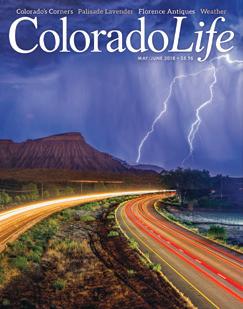
May/June 2018
Memorial Day 2010.
“Memories of war might have built the carousel,” Snow wrote, “but the happiness Harrison has since discovered keeps it turning.”
September/October 2017
The cuisine of Colorado’s Plains hints at an often overlooked part of its heritage.
“Wherever you see an old sugar factory in northeast Colorado, you can probably find a krautburger nearby,” we wrote. “This favorite local lunch is part of the cultural legacy of the Germans from Russia, the people whose work in the sugar beet fields fueled the region’s prosperity, but whose very existence has become obscured by history.”
Germans are from Germany, and Russians are from Russia – so what, exactly, is a German from Russia?
It all began in 1763, when the Russian Empress Catherine the Great invited Germans to settle along the Volga River in Russia. When the Russian government started oppressing them in the early 20th century, many emigrated to the United States to grow sugar beets in places like Brighton, Fort Collins and Greeley.
By the late 1970s, about 200,000 to 300,000 of Colorado’s 2.7 million residents were of German-Russian descent, but many had lost connection to their roots. Often, the food is one of the only remaining traditions from the Old World.
Some dedicated members of the community still meet regularly to participate in traditional Dutch Hop dances, but their numbers are declining. To Steve Deines, leader of the popular German-Russian Dutch Hop band the River Boys, the fading of the old culture has been bittersweet.
“They came to this country to thrive and grow and prosper,” Deines told us. “We think about the sadness of the music and the dancing dying, but in a way, I think it’s a happy ending. We accomplished what we came over to accomplish.”
Colorado Life Editor Matt Masich likes to tell people he travels to every corner of Colorado to find stories for the magazine. That has always been true in a figurative sense, but he decided to make it literally true by embarking on a mission to stand on the survey markers denoting each of rectangular Colorado’s corners. Photo Editor Josh Hardin came along to photo-document the expedition.
“This was … a mission to reveal the breadth of Colorado’s cultural and geographical diversity, to experience the full vastness contained within our state’s borders,” Masich wrote. “It also just sounded like a fun adventure, and except for the time Josh almost got eaten by a wolf, it was.”
While that was an exaggeration, Josh did encounter wolves while journeying to the state’s remote northwest corner, 100 miles’ drive from Craig, the nearest Colorado town. He had to drive his Jeep over deeply rutted, rock-strewn mountain roads to get there. Josh was just a halfmile from the corner when his vehicle got stuck in the mud, forcing him to camp overnight until help came.
One of the few sounds disturbing the silence during his unplanned camping trip was the howl of what he presumed were
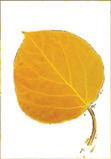


EXPERIENCE the splendor of the Rockies at Aspen Winds. The secluded setting along Fall River, among the aspen and pines, offers a relaxing atmosphere. Aspen Winds is located minutes from Estes Park and Rocky Mountain National Park. We offer one and two bedroom suites and in-room spa suites.
Kitchen/Kitchenettes • Gas Fireplaces Fire Pit • Free WiFi • Free Netflix Cable/Blue-ray DVD • No Pets • Non-smoking
970-586-6010 • 1-800-399-6010
1051 Fall River Court • Estes Park, CO ASPENWINDS.COM


Colorado Life Editor Matt Masich holds his baby daughter, Margot, while standing on the marker at the state’s northwest corner. Located 100 miles’ drive from the nearest Colorado town, the corner marks the spot where Colorado, Utah and Wyoming meet.
coyotes. When some local hunters arrived the next day to help pull his Jeep free, they told him there were rumors of a pack of wolves roaming the area. Colorado Parks and Wildlife confirmed the wolves’ presence 2 ½ years later.




May/June 2018
Hundreds of varieties of apples grew in Colorado at the turn of the 20th century. Most of those varieties were lost to time – until the Montezuma Orchard Restoration Project found them.
At the 1906 Colorado State Fair, apples from Montezuma County orchards surrounding Cortez won an incredible 101 out of a possible 104 ribbons. Varieties included such now-obscure types as Col-
orado Orange and Cedar Hill Black. But over time, the family-owned businesses that grew these apples began to disappear.
“People stopped growing apples, but their apple trees did not,” Jason Vaughn wrote. “As the decades passed, old and neglected trees continued producing those same incredible apples, as though waiting for new people to come along and rediscover them – people like Addie and Jude Schuenemeyer.”
The Schuenemeyers founded the Montezuma Orchard Restoration Project to find and preserve heritage varieties. It isn’t as simple as collecting seeds. To grow a particular type of apple, they must take a fruit-bearing stem, or scion, from the desired tree and surgically attach it to the rootstock of another tree.
The couple have repopularized the area’s apples and continue to scour the 200 historic local orchard sites to compile an authoritative database of Montezuma County’s agricultural legacy.
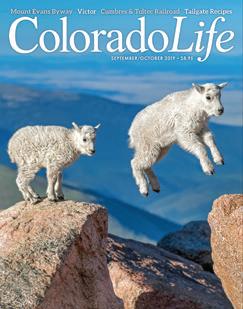

Trail Ridge Road in Rocky Mountain National Park is the nation’s highest continuous paved road. The black-footed ferret is coming back from the brink of extinction.
May/June 2019, July/August 2019, September/October 2019
In addition to having some of the nation’s tallest mountains, Colorado is home to the highest roads found anywhere on the continent. Colorado Life writers Tom Hess and Ian Neligh traveled some of these routes for our three-part “Highest Roads” series.
We began with Trail Ridge Road in Rocky Mountain National Park, the highest continuous paved road in the United States. This 48-mile section of U.S. Highway 34 between Estes Park and Grand Lake travels through alpine tundra to a maximum height of 12,183 feet.
Next, we took the Pikes Peak Highway up “America’s Mountain,” so nicknamed because Katharine Lee Bates wrote the lyrics to “America the Beautiful” after visiting its 14,115-foot summit in 1893. Because automobiles had just been in-
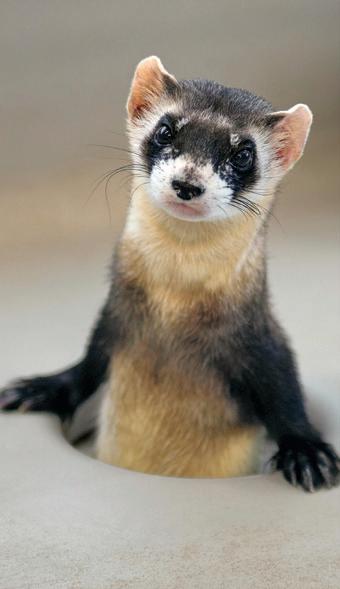
September/October 2020
At 2 feet long and weighing just 2 pounds, black-footed ferrets have a ferocity that belies their diminutive size. They once ranged across 12 Western states, including Colorado, using their sharp canine teeth to kill the prairie dogs that constitute 90 percent of their diet.
Human civilization and plague nearly eliminated the species in the 20th century, when black-footed ferrets were twice believed to be extinct. But the fierce creatures refused to die out. When the final remaining colony was discovered in Wyoming in 1981, U.S. Fish and Wildlife Service personnel captured the remaining 18
vented and the highway wouldn’t be built for another 22 years, Bates had to ride in a wagon and then atop a donkey to reach the top of Pikes Peak.
We saved the highest road for last, journeying up the Mount Evans Scenic Byway, the highest paved road in North America. The route reaches a height 14,130 feet; those who want to reach Mount Evans’ summit must hike the final 134 feet up. At the top, people often encounter adorably fluffy mountain goats – two of which were featured on the cover of the issue.
wild ferrets to start a breeding program. With only several hundred individuals now left in existence, the ferrets are still one of the most endangered mammals in North America. However, their future is looking brighter thanks to the work being done at the Black-footed Ferret Conservation Center near Wellington, where captive-bred ferrets live, hunt and raise their young in preconditioning pens before being reintroduced to the wild.

Nearly 40 years after the animals’ presumed extinction, the Black-footed Ferret Conservation Center’s Kimberly Fraser estimated there were 300 in captivity and nearly 500 in the wild, including 65 in Colorado.
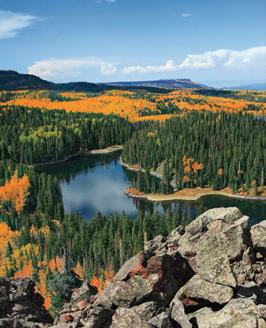



March/April 2021, May/June 2021
In a two-part series, Colorado Life took a journey through time to celebrate the iconic buildings that define Colorado. Famous edifices included Bent’s Old Fort, built in 1833 and rebuilt in 1976; the U.S. Air Force Academy Cadet Chapel, built in 1962; and the Denver Art Museum’s Martin Building, built in 1971.
Perhaps the most instantly recognizable building we featured was the Wells Fargo Center, the downtown Denver skyscraper better known as the Cash Register Building.
“Thanks to its unusual profile, the skyscraper has practically functioned as the city’s logo since it opened in 1983,”

Corinne Joy Brown wrote. “Amid canyons of steel and glass, where rectangular buildings are the norm, Wells Fargo Center’s exceptional curved glass roof changed the Denver skyline forever.”
Standing 52 floors and 698 feet high, the building is Denver’s third-tallest structure. Though it has become synonymous with Denver, Wells Fargo Center was originally designed for a city in Texas. Engineers had to make adaptations for the colder weather of Colorado, such as adding a heated roof to prevent snow from accumulating and sliding off the curved glass crown. That particular problem was solved – pedestrians on the street below have no need to fear being buried in a skyscraper avalanche.

villagegoldsmith.com



June 2
13 Day WWII Tour Includes France, Belgium and Germany
July 23
Exclusive Norway!
August 20
England, Scotland, Wales & Ireland






the Sandhill Crane migration in the Lake McConaughy, Nebraska area. With 363 species, it’s a year-round birding hotspot.
the Lake McConaughy App in the App Store or Google Play.



September 24
Unbelievable Europe –A Two Part Tour
Part One: Includes Oberammergau, Munich, Switzerland, French Alps and Monaco.
Part Two: Tour continues into Spain and Portugal. Do part one, two or both!







































recipes and photographs by NICOLE HAMPTON
BEING ABLE TO eat breakfast food for every meal is one of the perks of adulthood, according to Aurora food blogger Nicole Hampton. After spending more than a decade concocting high-altitude recipes, which she often shares on her blog, dougheyed.com, Hampton has assembled her favorite breakfast dishes in her latest cookbook, High-Altitude Breakfast from West Margin Press. Here are a few of the cookbook’s tasty offerings.
Popovers are an impressive yet easy thing to bake. Perfect for a fancy at-home brunch, these are best served warm from the oven and with a generous amount of butter, or split open and piled high with soft scrambled eggs.
In small bowl, stir together flour, salt and baking powder. Set aside. In large bowl, using hand mixer on high speed, beat together milk and eggs until frothy and a little thick, 5 minutes. Sift in flour mixture and beat on high until well incorporated. Fold in chopped herbs. Cover with plastic wrap and let batter rest at room temperature for 1 hour.
Preheat oven to 425°. Place six-cup popover pan in oven while it heats. When oven is hot, carefully pull hot popover pan out of oven and give cups a generous coat of cooking spray. Working quickly, pour batter into each cup, filling almost to top. Bake 15 minutes, then reduce oven to 350°. Bake until popovers are tall, puffed and deep golden brown, an additional 25 to 30 minutes. Remove popovers from pan and serve as quickly as possible with butter.
1 ¼ cups all-purpose flour
1 tsp salt
1⁄4 tsp baking power
1 ¾ cups whole milk
4 eggs
1⁄2 cup finely chopped herbs
(chives, parsley and thyme, or other preferred herbs)
Cooking spray
Butter for serving
Makes 6 popovers

Breakfast sausage links are wrapped up in pancake batter and fried. The cornmeal pancake batter gives the recipe a similar vibe to a traditional corn dog, but this is unmistakably its own breakfast beast. Any type of sausage may be used.
In large bowl, stir together flour, cornmeal, sugars, baking powder, baking soda and salt. In separate bowl, whisk together eggs, buttermilk and melted butter. Add egg mixture to flour mixture; use rubber spatula to stir together – some lumps are OK. Cover and let batter rest at room temperature 20 minutes.
Cook sausages in large skillet over medium heat until browned on all sides, about 10 minutes. Let sausages cool before proceeding. In large, deep pot, heat oil over medium-high heat until it reaches 375° on deep-frying thermometer. Line large baking sheet with paper towels for draining and set aside.
When ready to fry, in batches, dip cooled sausages into cornmeal batter to coat completely, letting excess batter drip back into the bowl. Carefully slide sausages into oil and fry until golden brown all over, 3 to 4 minutes. Using tongs, remove corn dogs from oil and place on prepared baking sheet to drain and cool. Repeat to batter and fry remaining sausage links. Serve corn dogs warm with maple syrup for dipping.
1 4 5 cups all-purpose flour
1⁄2 cup cornmeal
1⁄2 cup granulated sugar
1⁄4 cup firmly packed brown sugar
1⁄2 tsp baking powder
1⁄4 tsp baking soda
1 tsp salt
2 eggs
1 ½ cups buttermilk
1⁄2 cup butter, melted
1 12-oz package uncooked sausage links
5-6 cups canola oil, for frying Maple syrup for serving
Makes 14 small corn dogs
It took a lot of time to develop a successful yeasted doughnut recipe that works at high altitude, but this one is the winner. These doughnuts are fluffy, flavorful and perfect when dipped into cinnamon-sugar, chocolate icing or any other chosen coating.
Heat milk and water to 115°. Mix in sugar and yeast and set aside until mixture is foamy and bubbly, about 5 minutes. In bowl of mixer fitted with dough hook, mix eggs and yeast mixture with fork until just combined. Add bread flour, 3⁄4 cup all-purpose flour and salt. Mix on medium speed until very sticky dough forms; it will stick to the sides but should be very thick. If mixture seems too wet, add a bit more flour; dough shouldn’t completely pull away from sides of bowl. Using dough hook, knead dough on medium-low speed until dough starts to pull away from the sides of the bowl, five to 10 minutes.
While mixing, add butter 1 Tbsp at a time, letting it knead into dough before each addition. This process can take a while; you may need to scrape down sides of bowl to ensure that butter gets fully incorporated. Increase mixer speed to medium and knead dough for additional 10 to 15 minutes.
Test dough using window pane test: Pull off small chunk of dough and stretch it between your fingers. It should stretch without breaking until it is so thin you can almost see through it. Transfer dough to lightly oiled bowl and cover with plastic wrap. Let dough rise in warm, draft-free spot until it is about doubled in size. Roughly 30 minutes, though time may vary.
Scrape dough onto generously floured surface. Dough will still be fairly sticky. Using rolling pin, roll out dough to 1⁄2-inch thick. Cut dough into desired shapes using either doughnut cutter, or a 2 ½-inch round cutter and a small 1⁄2- to 1-inch round cutter for inside hole.
Line two large baking sheets with parchment paper; line third baking sheet with several layers of paper towels. Arrange cut doughnuts on the parchment-lined sheets and cover with plastic wrap. Let them rise until they spring back when touched, 10 to 15 minutes. Meanwhile, in a deep pot, heat 4 cups canola oil until it reads 350° to 375° on a deep-frying thermometer.
A few at a time, carefully add doughnuts to hot oil and fry until deep golden brown, about 1 minute per side. Use slotted spoon or metal skimmer to remove fried doughnuts from oil and place on paper towel-lined baking sheet to drain. Repeat to fry all doughnuts. Make your preferred coating. While doughnuts are still hot, toss them in cinnamon-sugar topping, if using, to coat fully. Transfer to lined baking sheet to cool. If using chocolate icing, drizzle it over cooled doughnuts and serve.

1⁄3 cup whole milk
2 Tbsp water
3 Tbsp sugar
1 Tbsp active dry yeast
2 eggs
1 cup bread flour
3/4-1 ½ cups all-purpose flour, plus more for rolling
1 tsp salt
4 Tbsp butter
4-5 cups canola oil
Cinnamon-Sugar Coating
Chocolate Icing
Makes 12 doughnuts and holes
Cinnamon-sugar Coating
1 cup granulated sugar
2 tsp ground cinnamon
In bowl with room for tossing the sugar around, stir together sugar and cinnamon.
Chocolate Icing
2 cups powdered sugar
2 Tbsp Dutch process cocoa powder
2-4 Tbsp water
1⁄8 tsp salt
In bowl, whisk together powdered sugar, cocoa powder, 2 Tbsp water and salt. Add more water if needed to reach consistency that drips off whisk in a thick ribbon.
The editors are interested in featuring your favorite family recipes. Send your recipes (and memories inspired by your recipes) to editor@coloradolifemag. com or mail to Colorado Life, PO Box 146, Timnath, CO 80547.



Steve Pulver/AKM Images
As inspiring as Colorado’s peaks are, mountain summits are inhospitable places – the state’s sheltering valleys are where most Coloradans spend their lives. From the Grand Valley to the San Luis Valley, our poets celebrate life lived at less rarefied elevations.
J. Craig Hill, Grand Junction
A leonine night wind roars up the valley And into the canyon on its way to DeBeque
The valley lies littered with signs of its passing The flotsam and jetsam left in its wake
Tumbleweeds stacked against fences and guardrails Windows blown out from a house on the ridge
Big sheets of Tyvek, torn from construction sites, Caught in the trees like some runaway kites
Ellen
Mackey, Littleton
In March we follow the wind Rushing from peaks, still snow-draped. Lifetimes ago the Spaniards saw The sunset reflected in the sawtooth range And named it Sangre de Cristo.
The gale gathers strength on the valley floor Throws the dried weeds husks Against barbed wire fences.
We turn east and pass alligators who, Unbothered by gusts, Smile from their geothermal pool. The new arrivals in this age-old valley, Show why they are the dinosaurs That survived the Ice Age.
We reach the Great Sand Dunes, Centuries of grains gathered up and Blown against the blue peaks, Nut-brown hills of silk Painted in the foreground.
Driving home, We pick asparagus from ditch banks Break off the fat sprouts. They taste of cactus and beginnings.
Robert Drummond, Montrose
Gullies, ravines and canyons Colorado’s land of many depths Not to mention the mountain highs Leading to valleys down low.
A parade of meandering scenes appearing along rugged terrain into valleys painted in a multitude of deep and pastel colors.
Outcrops of rocks give us strength to endure While depths of valleys bring spiritual renewal.
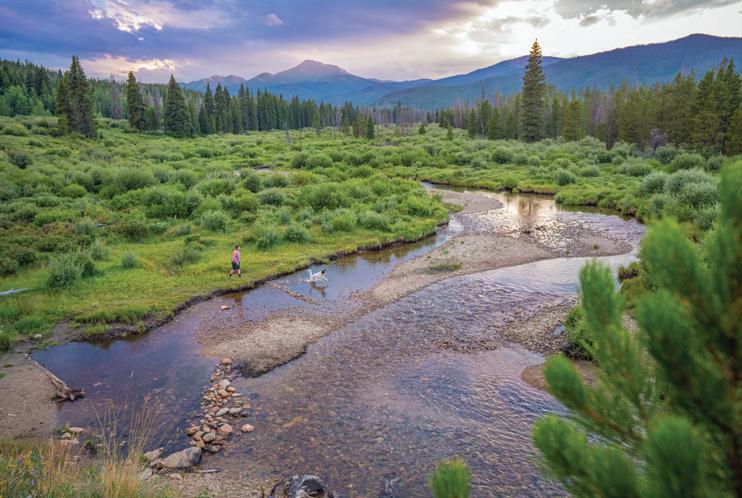
Morning light falls on Chicago Lakes in a steep glacial valley near Mount Evans. A dog and its human enjoy the light of sunset near Winter Park.
Sandy Morgan, Colorado Springs
The small woman is painting a place she has been but can’t remember where. She brushes in a vague sky, molds hills, makes a suggestion of a field and daubs in some trees; she winds a road through the valley and around a bend.
Then she sits back on her stool to see where she’s at and finds it doesn’t matter if she can replicate her point of inspiration or if she got it right: the scene opens like a third eye and invites the woman in, smudged cheek, small mind and all. She tosses down her brushes – knocking over a cold cup of tea – and follows the road past a clump of evergreens, skirts a field of something yellow-green, wends her way over one, two, three low hills –and disappears.
What will her husband do when he comes home for supper and finds that a landscape has swallowed his wife?
Michael Hartman, Monument
The valleys did not exist
Nor the peaks, nor the rivers
No streams, no ravines
No boulders, precariously perched
To tumble into the abyss
Everything waited
Broad expanses of mesas and flatlands
Covered by glaciers … measured deep
To thousands of feet
Frozen scalpels, eagerly awaiting
The sculptors’ first strike
Or perhaps just a thoughtful nudge
In all directions, equally lay
Granite and quartz, marble and sandstone
The form, the texture, the patterns
Trembling undulations, carefully disguised as one
Teasing the eye
Pleasing the brain
Warming the heart
And at a point of time and space
Unknown to all but one
A burst and moment of intense inspiration
Came forth as light and warmth
Assailed our bluish spinning orb
Glacial ice
Wildly wind-sculpted snowfields
Icicles dangling in boredom
All morphed into a swirling whirlpool
Carving earth and seas and canyons unnamed
Peaks now to climb, mountains to ski
Sculpted valleys giving life to each
Rivers to raft and oceans to reach
Reflecting all at day’s perfect end …
I would surely trade a grain of sand for each.
DO YOU WRITE poems about Colorado? We’re looking for poems about “Wilderness” for July/August, deadline May 1, and “Colors” for September/October, deadline July 1. Send your poems, including your mailing address, to poetry@coloradolifemag.com or to Colorado Life, PO Box 430, Timnath, CO 80547.

A local legend tells tales of the ski town’s rough-and-tumble days
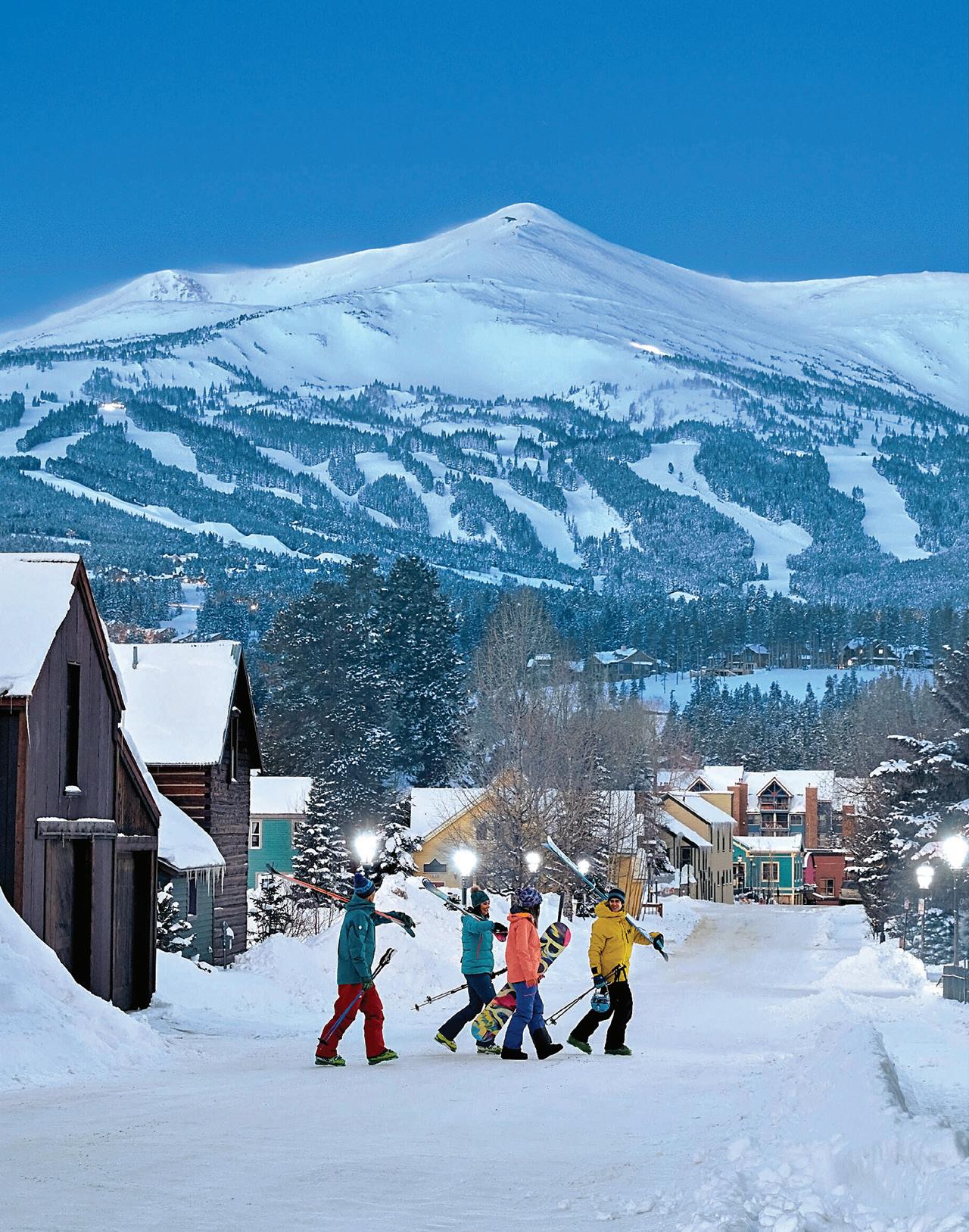
Breckenridge Resort has repeatedly been named the nation’s most-visited ski area.
The town started in the 19th century as a mining boomtown.
Breckenridge was a sleepy mining town with a small, relatively new ski area when Jeffrey Bergeron moved there nearly 50 years ago. Since then, the town has transformed into a worldwide destination, with Breckenridge Ski Resort frequently ranked the most-visited mountain resort in the nation. Bergeron is now mayor pro tem on the Breckenridge Town Council, as well as a columnist and author who often writes under the pen name Biff America.
THE CAR WAS loaded and leaking oil on my parent’s driveway. It was 1974, and my best buddy Keith and I were leaving the South Shore of Boston, bound for Breckenridge, Colorado.
The trip was both an adventure and escape from parental ultimatums. My mum wanted me to go to college; my dad wanted me to learn a trade. I didn’t have the attention span for one or the energy for the other.
Like many of the disaffected during the ’60s and ’70s, we could not see ourselves living the lives expected of us. We knew what we didn’t want but were unsure of other options. We heard from a friend of a friend that Breckenridge was a wild place, lacking rules and traffic. Though I had only one picture postcard as a frame of reference, I saw it as a potential place where guys like us could perhaps redefine ourselves and wear cowboy hats.
Breckenridge was also making a name for itself as a fledgling ski resort just north of 10 years old. Its reputation as wild and free appealed to me, though I was unsure about the skiing aspect.
My buddy Keith was raised a Lutheran, and with his church group he had gone on a few ski trips to New Hampshire. Me being Catholic … my people boxed. My friend assured me that I would pick up skiing quickly, and since he had skied three or four times before, he would be considered an “expert.”
We loaded up a 1968 Volkswagen station wagon that we bought from a
by JEFFREY BERGERON
bartender named Phil for $700. The car was in good shape, except for the body and engine.
Other than a few family vacations to New Hampshire, this would be the first time I had left Massachusetts. The first few miles of our journey took us through our hometown, past the places where we would bicycle to sandlot football and Little League games. Unbeknownst to us, we would never again live full-time in the town that once was our world. In the pocket of my leather jacket, I carried the postcard with the Breckenridge address of that friend of a friend, who we thought might let us crash on his floor until we got settled.
As we approached the Massachusetts state line, I had the grandiose illusion that we were the incarnation of Jack Kerouac and Neal Cassady, but in truth, our only resemblance to Kerouac was our East Coast dialects.
WE ARRIVED IN BRECKENRIDGE on a clear day in mid-October. Main Street reminded me of the town featured in the TV show Gunsmoke.
There were two Breckenridges back then: One was a fledgling ski hill and a few lodges serving what many hoped would become a popular ski resort; the other was a wild place filled with miners and mountain-man-hippies long on resilience, short on grooming. There were wooden sidewalks and dirt streets. Draft beer was a quarter, and a wild purity
prevailed. It was not uncommon to see an occasional horse tied outside of a bar or a dog sleeping in the middle of the road.
With a rich history of mining dating back to the 1800s and lasting off and on until post-World War II, the mountains surrounding town were full of old, abandoned cabins. During the late ’60s and ’70s, many hippies (for a lack of a better phrase) fixed up those cabins and lived off the grid. There were old ghost towns that were revitalized where five or 10 cabins would be fixed up, forming small communities.
A prime location for a cabin would be one where the occupants could cut a hole in the ice of a nearby stream to access water. Other than that, running water was an unheard-of luxury.
Since the only marketable skills Keith and I possessed were with the service industry, we needed a place with a
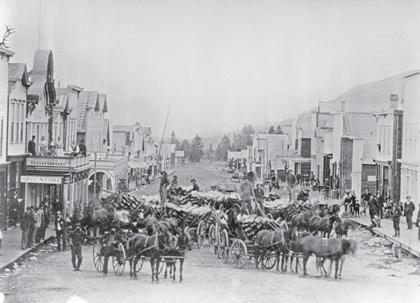

shower. We rented a two-bedroom condo for $250 a month; the same place now would now go for more than $3,000.
As luck would have it, running water was our foray into the high country social scene.
About half of the folks we met that first winter lived off the grid without running water. We often invited our new friends home to use our shower, and on occasion we would join them. The rumor soon spread that we were a full-service facility.
ON ONE OF OUR first nights, we entered a local bar with both excitement and fake IDs. We were only a few dollars into our quarter-beer budget when we noticed an altercation brewing at the bar. Both of us, having grown up around working-class saloons and schoolyard battles, were well acquainted with fist fighting.
We had watched the quarrel brewing for almost an hour. At the time, Breckenridge had unlimited parking and a half dozen single women. There were two scraggly looking guys both vying for the attention of one scraggly looking gal. The gentlemen in question wore beards, long unkempt hair and faded jeans tucked into heavy boots. Except for the beard, the gal
looked much the same.
It seems all was orderly until they lost track of whose turn it was to buy the lady her beer. Both slapped money on the bar, and a pushing match ensued. When we heard the words, “Let’s settle this outside,” we knew it was go time.
Virtually everyone, including the bartender, filed out the door. The two combatants were joined on the street by an older guy in a long jacket, cowboy boots and hat. He seemed to be giving rules or instructions. The gal in dispute looked on like the desired damsel she was.
Keith and I moved closer for a better view. But rather than throwing punches, the fighters backed off from each other and opened their coats. That’s when Keith said, “Jeez, Berger, these guys aren’t going to throw punches – they’re going to start shooting.” I remember inching over behind the largest guy I saw.
The referee looked at the crowd and said, “Give ’em room.” He turned to the battlers and added, “Don’t neither one of you polecats move until I say ‘go!’”
The two stood 10 feet from each other with their arms held out from their hips.
“Go!”

Their hands flew to their belts. But rather than draw guns, they fumbled with their buckles. In a flash, one was standing with his pants down to his knees with his red long underwear visible to all. The other was a few seconds behind and was declared the loser.
The fighters shook hands. A cheer went up from the crowd and, with much celebration and back slapping, all returned inside.
WE WERE IN BRECKENRIDGE less than a week when Keith lied about his age and got a job tending bar, and I lied about my experience and got one waiting on tables. The problem was our jobs

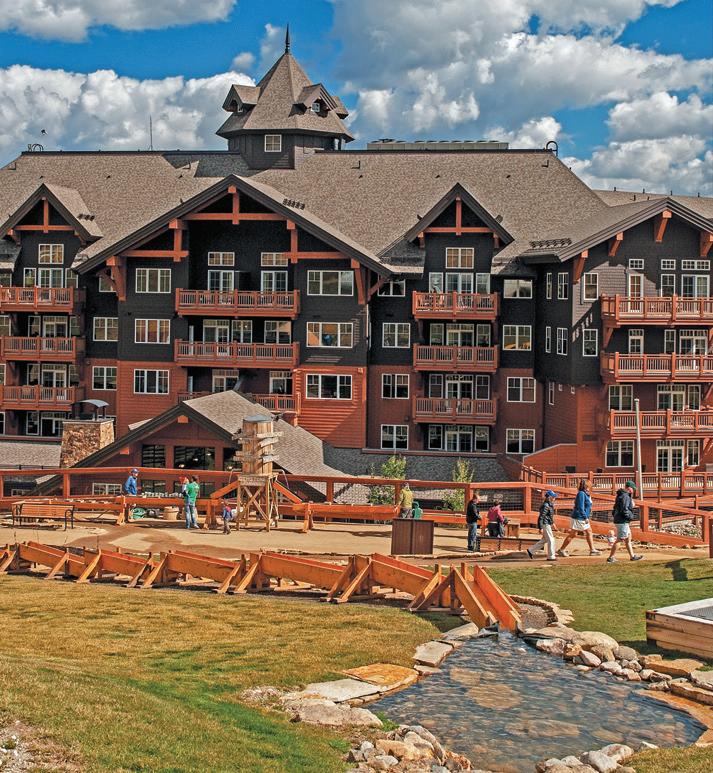
Pajama-clad

didn’t begin until the ski resort opened on Thanksgiving, and we had arrived in mid-October.
After paying rent and doing the math, we had concerns that we might not last until late November. We even considered moving to Denver, where the work would be steadier. Lucky for us, after a night of celebration, Keith rolled our Volkswagen into the Blue River, making a move more difficult.
In his defense, Keith did have a reason to celebrate – he had won a dog sled race earlier that day.
The buzz around town had been that there was going to be some sort of dog sled race around Lake Dillon, with mushers coming from all around the West to compete. Two local bars, one of them where Keith was slated to work, entered teams. But rather than have dogs pulling a musher, these bar owners decided to have a pack of humans pulling a dog sitting in a toboggan.
When the organizers realized what was going on, they created a separate category, distance (about 100 yards) and start times so the human dogs would not get bitten by the real ones at the start. Keith’s team was in second place until the lead dog/human tackled one member of the opposing team, bringing them all down. Keith’s team was the first on their feet and won the race.
As I recall, the winning team’s prize was a case of Yukon Jack Canadian whiskey.
FOUR DECADES LATER, I stopped by a celebration of the final night of ownership of a local tavern. It was one of the last vestiges from the old times, and only a stone’s throw away from the one that hosted the aforementioned quickdraw contest.
I saw some of the same faces who once lived in cabins, and even some who shared our shower. Like me, they have made a home and found success 2 miles above sea level. Those former cabin dwellers are now contractors, teachers, businessmen and -women, and commu-
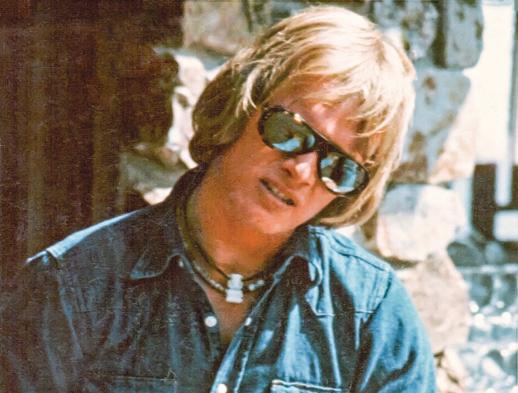
was easy, or that they had nowhere else to go, but because they loved this town. They stayed because this place is special. And giving credit where credit is due, Keith was correct: I picked up skiing “in no time,” if you consider no time as decades. On a good year, my wife and I might begin cross-country skiing in late October on the same trails we mountain bike on during the summer. When the lifts begin running, we mix up riding lifts with backcountry skiing on our nearby

untracked mountains. Usually, our last backcountry ski days are on the summer solstice or the Fourth of July.
Breckenridge is not the same place it was when I arrived. Over the years, I have attempted to throw a wrench into the works of growth and expansion. But what I considered sprawl, others thought of as progress.
Though I lost more battles than I won, I will admit that with growth came three additional peaks to ski inbounds, miles of hiking, biking and cross-country skiing
Although Jeffrey Bergeron didn’t know how to ski when he moved to Breckenridge, he already looked the part of a 1970s ski bum. Today, he serves on the Town Council.
trails, a golf course and an amazing recreation center. I’d like to say the young and wild crowd still fights to win the heart of a lady by pulling down their pants on the street, but I would imagine that with the skinny jeans popular today, it would be a challenge.
And speaking of that gunfight so long ago, the next day, I wrote my mother telling her that I had found where I belong. And though I miss the old days, I’m nonetheless certain that Breckenridge is where I am meant to be.




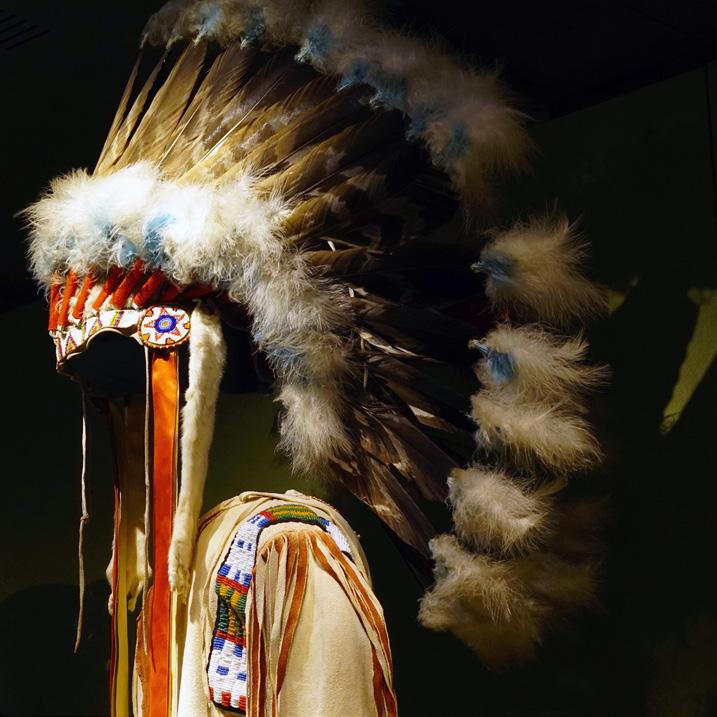






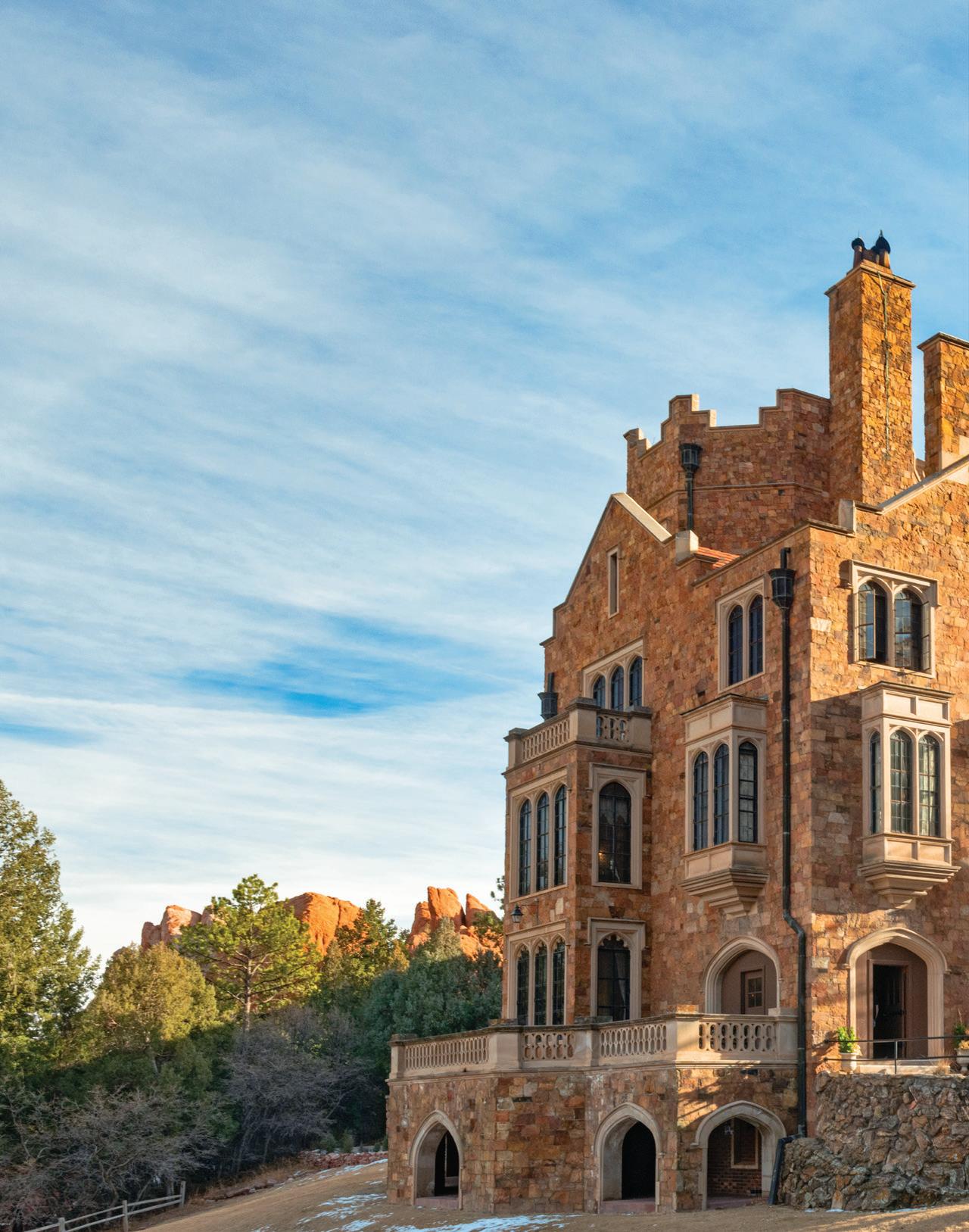
The castle Colorado Springs’ founder built over the ridge from Garden of the Gods

CARS WITH LICENSE plates from across America snake south on two-lane 30th Street toward Garden of the Gods, the red rock park just over a ridge from Colorado Springs. But a few vehicles stop short of the geologic wonder, turning instead at a sign reading “Navigators/Glen Eyrie.” Ahead of them rises a hidden castle.
Driving west through a valley of tall pines and rock, motorists seem to pass from one world to another – from city traffic to something like the fantastical land of Narnia that author C.S. Lewis imagined hidden within a plain wardrobe. A space at the foot of the Rocky Mountains opens up like a wardrobe door to reveal a timeless place known as Glen Eyrie.
The centerpiece of Glen Eyrie is a stone castle. Historians might say it is not truly a castle – that, technically speaking,
it is an English Tudor revival-style manor house with a Gothic revival tower and castle-style stonework. It is the tower that leads visitors to think of Glen Eyrie as a castle, and the name Glen Eyrie Castle stuck.
In Colorado Springs, Glen Eyrie is best known for two things: being the former home of city founder William Jackson Palmer and for serving traditional English afternoon tea. Historian and author Susan Fletcher is a fan of both.
Seated at a table beside a tower window, Fletcher selects her tea – a blend of dried lavender, amaranth and jasmine flowers that blossoms into a bright bouquet as it is poured into the glass teapot. Next, a three-course tray arrives, placed on a spotless white tablecloth. The bottom level is loaded with dainty shrimp and ham tea sandwiches, the second with lemon
blueberry scones and cream, and the third with sweets.
The window frames an outside view filled with the color and texture of its seclusion: trim green lawns that feed brown-coated bighorn sheep, and raw red rock spires that safekeep yellow-beaked bald eagles. The inside view hints at English elegance, with wainscotting panels, muted green painted stucco and tiedback, floor-length curtains.
As Fletcher’s fragrant floral tea steeps, she explains why she’s dedicated more than two decades to studying Palmer, the man who built Glen Eyrie Castle. A Civil War hero and Medal of Honor recipient, a railroad owner who shared his wealth with his employees, a builder who preserved a peaceful place in Colorado Springs that could bring comfort to others – Palmer was a human being Fletcher could admire.
Tour guide Pete Gawda introduces visitors to Glen Eyrie Castle before leading them through the front door. Though the structure has long been called a castle, it would more accurately be called a Tudor-style manor house with castle-style stonework.

PALMER HAS FIGURED prominently in Fletcher’s life. She graduated in 1998 from Colorado Springs’ Gen. William J. Palmer High School, which adjoins the intersection where a statue of Palmer mounted on a horse stands at the center, his eyes turned toward Pikes Peak.
As a high school senior, Fletcher wrote a 10-page paper on Palmer. Weeks later, she put on a fancy dress to celebrate her 18th birthday with tea at Glen Eyrie. More than two decades later, Fletcher is still writing about Palmer. Her latest book, The Glen Eyrie Story, co-authored with Glen Eyrie bookstore manager Amy Burch, begins with a chapter on the remarkable life Palmer led before he built this castle.
Palmer grew up in a Pennsylvania Quaker family and followed the faith’s pacifist teachings – until the Civil War broke out.
“He wrote a letter to one of his best friends,” Fletcher said, “saying the moral wrong of slavery outweighs the moral wrong of war.”
Palmer was the colonel in charge of a Union cavalry regiment, the 15th Pennsylvania, then served as a spy behind Confederate lines, tracking and reporting the movements of Gen. Robert E. Lee’s army.
Captured and imprisoned during a spy mission, Palmer guarded his identity and adopted a new one, avoiding execution and securing his release. He later received a promotion to brevet brigadier general from President Abraham Lincoln and led a Union victory at Red Hill, Alabama, that earned him a Congressional Medal of Honor.
Fletcher honors Palmer’s war service, but it is Palmer’s generosity as an employer that she finds extraordinary. Palmer built, owned and sold railroads – among them the Denver and Rio Grande Western.
“He sold the railroad for more money than he thought he would, so he took the extra money, got on a train, and divided it to every employee, from workers at the lowest level through the executives,” Fletcher said. Such kindness was rare. “Nineteenth century industrialists were not known for caring about their workers or being generous.”
Palmer invested most of all in Colorado Springs, the city he founded in 1871. He had a vision for improving the community,
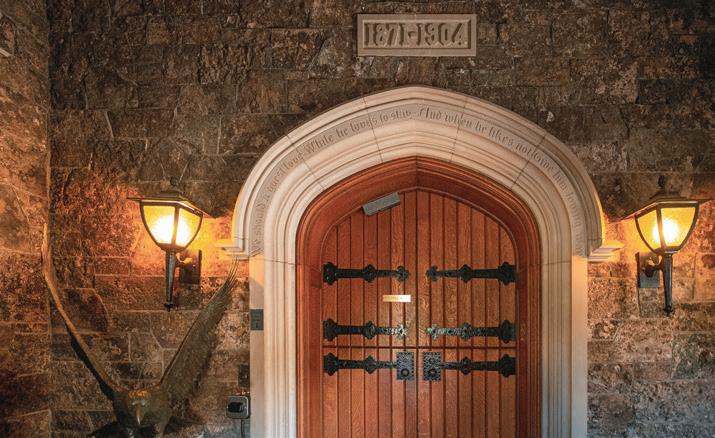

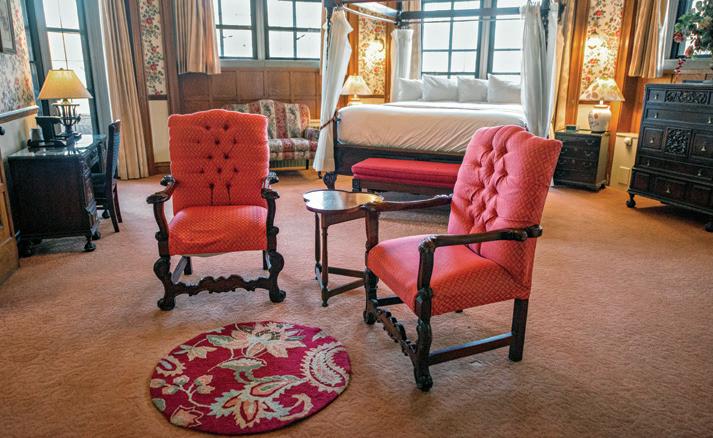
building schools, parks, churches, planting trees and striving to make it one of the most beautiful places in the West.
Fletcher is director of history and archives for The Navigators, the Christian ministry that now owns Glen Eyrie, giving her access to Palmer’s correspondence about Glen Eyrie. Among the letters Fletcher has read was one in which Palmer wrote to his wife, “Could one live in constant view of these grand mountains without being elevated by them into a lofty plane of thought and purpose?”
Fittingly for a railroad man, Palmer met the woman who became his wife, Mary “Queen” Lincoln Mellen, aboard a train. Queen earned her nickname during her childhood in Kentucy. Not only did her beauty capture Palmer’s heart, her love of art and music did as well. They exchanged letters, attended lectures and the theater together, and were soon engaged.
Palmer’s letters persuaded Queen to overcome her initial reluctance and join him in a rugged life in Colorado. She named the red rock formations on the Glen Eyrie grounds, including the most arresting formation, Major Domo, a red rock sentry standing guard over the estate.
However, Queen never saw the Glen Eyrie Castle. After a heart attack in the mountains, Queen moved with the couple’s three daughters from Colorado to lower elevation in New York in 1884, and then to England. She died there in 1894. The castle was built a decade later. Palmer never remarried; no one could replace his Queen.
THE SAME YEAR that Palmer founded Colorado Springs, he began construction of a wood-frame home in Glen Eyrie above Camp Creek, northwest of Garden of the Gods. In 1904, Glen Eyrie Castle replaced the original home. Palmer loaded it with innovations of that era, such as an elevator, electricity generated by a power plant on the property, a built-in fire suppression system and a telephone.
Palmer was a frequent traveler to Europe, where he explored less smoky forms of coal for his train engines. According to Palmer’s valet, Johnny Mathys, the Tudor manor house at Loseley Park in Great Britain inspired Palmer’s vision for Glen Eyrie. His castle’s stones



were mined from nearby Bear Creek Canyon, among other locales.
He sent back from Europe fixtures for his castle that he found fascinating: a monastery fireplace mantel, red roof tiles and more. So much was delivered so frequently that the sources often were not cataloged.
Glen Eyrie is Scottish for “valley of the eagle’s nest,” so named because Scottish landscape architect John Blair spotted eagles and their nest on Palmer’s property. An eagle’s nest is still there more than 150 years later, surviving fire, ice and wind.
EAGLES, BIGHORN SHEEP and weary travelers alike find a haven at Glen Eyrie. Building the castle and preserving the grounds brought peace to a grieving Palmer, who had hoped that he and his bride would delight in the Glen forever.
Palmer died in 1909, three years after being paralyzed after falling from
his horse during a ride to Garden of the Gods. After their father’s death, Palmer’s three daughters tried selling Glen Eyrie to the city of Colorado Springs, but the city didn’t want to bear the burden of maintenance costs. Tumult followed.
Oklahoma investors hoped to subdivide the property into luxury estates, but World War I and the Spanish Flu pandemic sank their plans. An auction that divided the property into two parcels failed when the winners didn’t pay up. A wealthy man with tuberculosis bought the Glen in part for his health, but his heart followed a wayward opera star, leading him away from Colorado and to an early grave. A Texas oilman bought the Glen as a summer home for his young family, but when his children grew up and moved away, he lost interest.
Meanwhile, as that drama was unfolding in Colorado, Christian missionary Dawson Trotman was in California, working to start a ministry. In 1933, he found-

ed The Navigators, so named because Trotman’s first converts were U.S. Navy sailors. By the 1940s, he had befriended up-and-coming evangelist Billy Graham, who sought Trotman’s help ministering to people who converted at Graham’s big tent and stadium events.
Graham and Trotman visited Glen Eyrie and considered buying it together. Graham backed out, but he encouraged Trotman to buy it for The Navigators. Trotman was then responsible for raising money for the down payment, a price that seemed beyond his group’s means. The Navigators raised the money by the final day, at the last minute, with Trotman flying to the closing before the final donation that put him over the top had been secured.
THE NAVIGATORS OPERATE Glen Eyrie as a lodge and conference center, booking 95 guest rooms in seven buildings, including 17 rooms in the castle.
It is not in the castle but in a secret nook above Major Domo that Dace Starkweather, Glen Eyrie’s current general manager, finds the solitude he sometimes needs in the round-the-clock job of serving guests.
From his perch, he gazes at the pink rock formations of Echo Rock Canyon. It is a place, he said, “where I can be high enough above everything else and above my other thoughts.”
To Starkweather, excellence in hospitality means it must be personal, whether leading guests on hikes, or joining them for tea. Guests become friends, and friends become family. People tell him their stories and talk about what Glen Eyrie means to them.
A Manitou Springs High School teacher who needed a break from the classroom told Starkweather how “this peace came over me” on her visit to Glen Eyrie. She came back three days later, “and it happened again.”
A Gold Star mom who grieved over the death of her son in battle had considered giving up on life, but after a visit to Glen Eyrie she began attending church, “opening the door of relationship with other moms going through the same thing,” Starkweather said.
Guests also experience peace as they observe wildlife taking refuge at Glen Eyrie. More than 80 bighorn sheep graze the lawns, especially in October, when moun-
tain foliage dies off and Glen Eyrie is still watering its grass. Forty wild turkeys run throughout the 723 acres.
FOR A TIME IN 2012, it seemed that wildfire might consume Glen Eyrie – its castle, forest and wildlife.
Glen Eyrie’s director of operations, Derek Strickler, received a call while traveling through Kansas that smoke had been spotted above Glen Eyrie. With the surrounding forest exceedingly dry from severe drought and record high temperatures, the fire in nearby Waldo Canyon raised alarm. Strickler’s wife drove their car back to Colorado as he held a phone to each ear, receiving updates and giving directions.
At the first sign of smoke, staff evacuated from The Navigators’ Eagle Lake Camp above Glen Eyrie on Saturday, June 23, to First Presbyterian Church downtown. The young campers had departed the previous day, Strickler said, the only blessing on that terrible day.
On Saturday afternoon, the fire began creating its own weather pattern. “Instead of the fire moving uphill, as fires do,” Strickler said, “a thunderstorm pushed it all downhill, which is pretty rare.” Within

two hours, trees were burning immediately west of Glen Eyrie.
By Tuesday, June 26, at 4:30 p.m., only Strickler and one other staff member remained on the property. Strickler could see the fire coming down the ridge toward the castle. “The trees were so dry, they were exploding,” he said. “It sounded like firecrackers. I told our longtime facilities guy, ‘We’ve got to go. Go, go, go, get out, get out. We’ll leave it in the firemen’s hands.’ ”
The next morning, Strickler arose at 5 a.m. and rode a bicycle to the property. A log on a hiking trail had burned, but nothing else. Bighorn sheep had gathered on the walkway up to the castle’s front door, as if they knew they would be safe there.
As they have for more than a century, wildlife and people alike continue to find peace at Glen Eyrie. And the castle that has stood as a symbol for many things –Palmer’s love for Queen, God’s love for humankind – is still standing in the valley of the eagle’s nest.



by KRYSTN POWERS
MARCH 5 • DURANGO
When it comes to competitive snowsports, skiing and snowboarding competitions are among the first to come to mind. But what about a tubing relay race? The Purgatory Resort in Durango has it covered.
Uncle Clyde’s Run & Slide was inspired by Purgatory Resort Events Director Matthew Krichman’s personal curiosity about endurance and stamina.
Purgatory Resort has a phenomenal tubing hill, Krichman said. “I always looked at it and thought, I wonder how many laps I could do just sprinting up and tubing down? And how long it would take if you were sprinting as fast as you can to do a lap?”
The event is a tag-team relay race. Teams of two take turns running up the hill and tubing back down. The goal is to complete as many laps as possible in the 60- or 90-minute heats. There are male, female and co-ed divisions for adult teams, as well as parent/child teams and kids’ categories. Costumes are encouraged.
The event attracts a wide assortment of competitors. There are a lot of moms and dads with kids who are just looking to have a fun time, Krichman said. And then there are a handful of serious runners who are there to really test their lung capacity. (970) 247-9000.
Competitors see who can slide down Purgatory Resort’s tubing hill the most times in this fun relay.
Scott DW Smith/Purgatory Resort
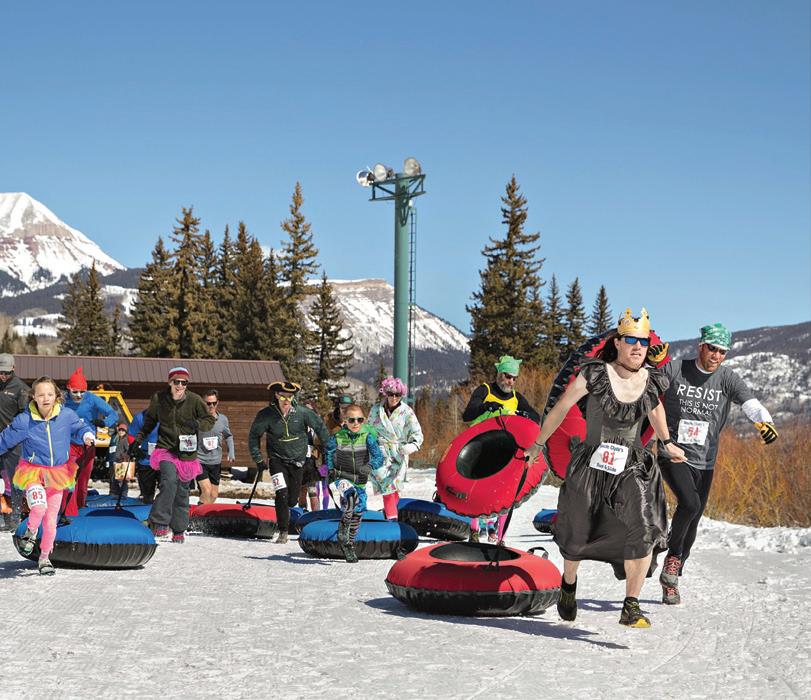

The Victorian hotel in downtown Durango’s National Historic District was built in 1898. Located next to the Durango & Silverton Narrow Gauge Railroad depot, the General Palmer Hotel is within walking distance of restaurants, shopping, art galleries and theaters. The hotel has 39 uniquely styled rooms, patio decks on the second and third floors, and free parking. 567 Main Ave. (970) 247-4747.

Father-son duo Jaime and Marcos Wisner introduced Durango to its first permanent food truck collective. The concept marries Ernie’s Bar and Taste Coffee with a handful of food trucks that serve up a variety of cuisines, from wood-fired pizza to clam chowder, and sliders to smoothies. 1101 Main Ave. (970) 422-8482.

Housed in an old coal-fire steam-power AC generating plant, The Powerhouse is an interactive science center for people of all ages. The Powerhouse collaborates with museums and other science centers around the country to offer guests a variety of exhibits, programs and activities. 1333 Camino del Rio. (970) 259-9234.

APRIL 1-2 • ESTES PARK
Bigfoot appeals to a big fanbase – from casual fans, who enjoy the fun and kitschy elements of the legend, to serious sasquatch scholars, who make it their life’s mission to find bigfoot in the wild. Estes Park’s Bigfoot Days is an event designed for all types.
For the true believers, the festival has booked some of the biggest bigfoot-related celebrities – short of bigfoot himself –to give talks and do meet-and-greets with attendees.
Presenting the latest findings from his sasquatch field research is Cliff Barackman, star of Animal Planet’s Finding Bigfoot and head of the North American Bigfoot Center. Also making an appearance are Joe “Huckleberry” Lott and William “Wild Bill” Neff, the West Virginia bigfoot hunters who star on the Travel Channel’s Mountain Monsters.
“If you’re into bigfoot, these are the guys you want to meet,” Estes Park Special Events Coordinator Kevin McDonald said.
But there’s just as much fun to be had for those who don’t necessarily believe in bigfoot. Family-friendly activities include expeditions into the nearby mountains –which are spectacular with or without sasquatch sightings – and getting an up-close look at the original Bigfoot monster truck, brought in specially for the event.
Bigfoot Days begins Friday night with a ticketed dinner, where attendees can mingle and take pictures with the celebrity guests. Saturday is a free event open to all. It includes presentations from the bigfoot experts, more photo and autograph opportunities, live music performed by That Damn Sasquatch, and craft and food vendors. (970) 586-6104.

Nestled against Fall River between Estes Park and Rocky Mountain National Park, Castle Mountain Lodge has more than a dozen cabins that can accommodate anywhere from two to 13 people. More than half of the cabins are dog friendly, and seven have private hot tubs. 1520 Fall River Rd. (970) 586-3664.

Offering tours year-round, Wildside 4X4 Tours treats guests to photo-worthy vistas in Rocky Mountain National Park and around Estes Park. Tours take place in vehicles customized to allow for a wider viewing range and include stops where guests can hike around for photo opportunities away from the road. 212 E. Elkhorn Ave. (970) 586-8687.
Estes Park becomes the center of the sasquatch universe during the town’s annual Bigfoot Days celebration.
BOULDER INTERNATIONAL FILM FESTIVAL
March 3-6 • Boulder
With Alec Baldwin as special guest, local, national and international filmmakers and movie enthusiasts gather to celebrate film. In addition to screenings, the festival includes opening-night galas, filmmaker happy hours, events with nationally renowned chefs, a singer-songwriter showcase and a closing night awards ceremony. (303) 449-2289
NATIONAL COIN & MONEY SHOW
March 10-12 • Colorado Springs,
More than $100 million worth of rare and historic coins and paper money are on display at the Broadmoor Hotel. Dealers are on hand selling unique money and tokens. Seminars teach collectors how to grade coins and identify counterfeits. Attendees can also bring their own numismatic treasures to be appraised. (719) 632-2646
DENVER ST. PATRICK’S DAY PARADE
March 12 • Denver
Denver’s annual St. Patrick’s Day Parade returns for its 60th anniversary. The best place to view entrants’ full dance routines and musical sets is south of 20th Avenue on Blake Street, renamed Tooley Street for the parade. The event regularly draws more than 200,000 people, so use of public transportation is encouraged. denverstpatricksdayparade.com
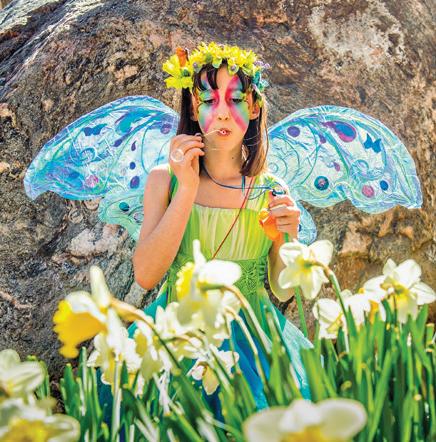
Children
Spring in Boulder doesn’t officially begin until the Tulip Fairy says so. At this quaint kiddie festival, the Tulip Fairy leads parades of costumed children to celebrate the return of the Pearl Street Mall’s 15,000 tulips.
The ostensible purpose of the festival is for girls and boys – many dressed as fairies and elves – to either “wake up” or “welcome” the tulips, depending on whether the flowers have bloomed yet. But for many young participants, the festival is all about the costumes, said Anna Salim, vice president of events for the Downtown Boulder Partnership.
“It’s Halloween in the springtime,” Salim said. “For kids, this is an opportunity
to get dressed up. We have lots of tulip fairies and elves, but we also have lots of Spider-Mans and Batmans.”
The event runs from 1 p.m. to 5 p.m. on the 1300 and 1400 blocks of the brickpaved Pearl Street Mall. Live entertainment is on the main stage in front of the Boulder County Courthouse. The musical lineup features talented musicians, including local children’s duo Jeff and Paige, who always close out the festival.
Children enjoy free activities like foam sword dueling, collaborative art projects, seed planting and cookie decorating. There’s face painting for a minimal charge, plus plenty of free photo ops with the Tulip Fairy herself.


The Tulip Fairy has been portrayed since 2007 by Boulder resident Debra Ordway, a former costume shop owner who created her own elaborate Tulip Fairy outfit. Originally, she led the Tulip Fairy and Elf Parade as part of the Boulder in Bloom Festival. When that festival was discontinued, the popular Tulip Fairy component was spun off into its own event.
If April showers fall on the festival date, the rain date is May 1. (303) 449-3774.

This breakfast and lunch spot has been a favorite in Boulder for more than two decades. The menu is full of traditional fare like omelets, pancakes, salads and sandwiches. There are also more unusual signature dishes, like the Boulder scramble which – spoiler alert – does not contain eggs. 3073 Walnut St. (303) 447-2315.
March 12 • Frisco
Hosted by the Frisco Nordic Center, BrewSki is a beer festival where participants cross-country ski from tent to tent tasting beers from eight different Colorado breweries. Costumes are encouraged at the family friendly event; children are welcome and receive a free root beer float at the afterparty. A portion of the event’s proceeds go to Friends of the Dillon Ranger District. (970) 668-2570.
March 16 • Steamboat Springs
One part snowshoe excursion, one part geology tour and one part history lesson, the Snowshoe Through History tour promotes an environmental and cultural appreciation of the Yampa Valley by way of Steamboat Springs’ Legacy Ranch. The tour is free with RSVP and open to participants age 16 and older. (970) 871-9151.

March 19-April 10 • Wray
Once on the endangered species list, the greater prairie chicken has become one of northeast Colorado’s most fascinating spring attractions. Sunrise tours north of Wray allow birders to witness the chickens’ flamboyant mating ritual, in which the males dance for the females and make a unique, low sound akin to blowing air across the top of a glass bottle. (970) 332-3484.
April 6-9 • Vail
A showcase of more than 30 Vail chefs and almost 50 wineries, the annual Taste of Vail offers a snapshot of the best that Vail’s ever-changing culinary scene has to offer. This year’s event highlights include a rosé wine tasting, an apres food tasting on the streets of Vail and a mountaintop food, beer, wine and spirits tasting. (970) 401-3320.
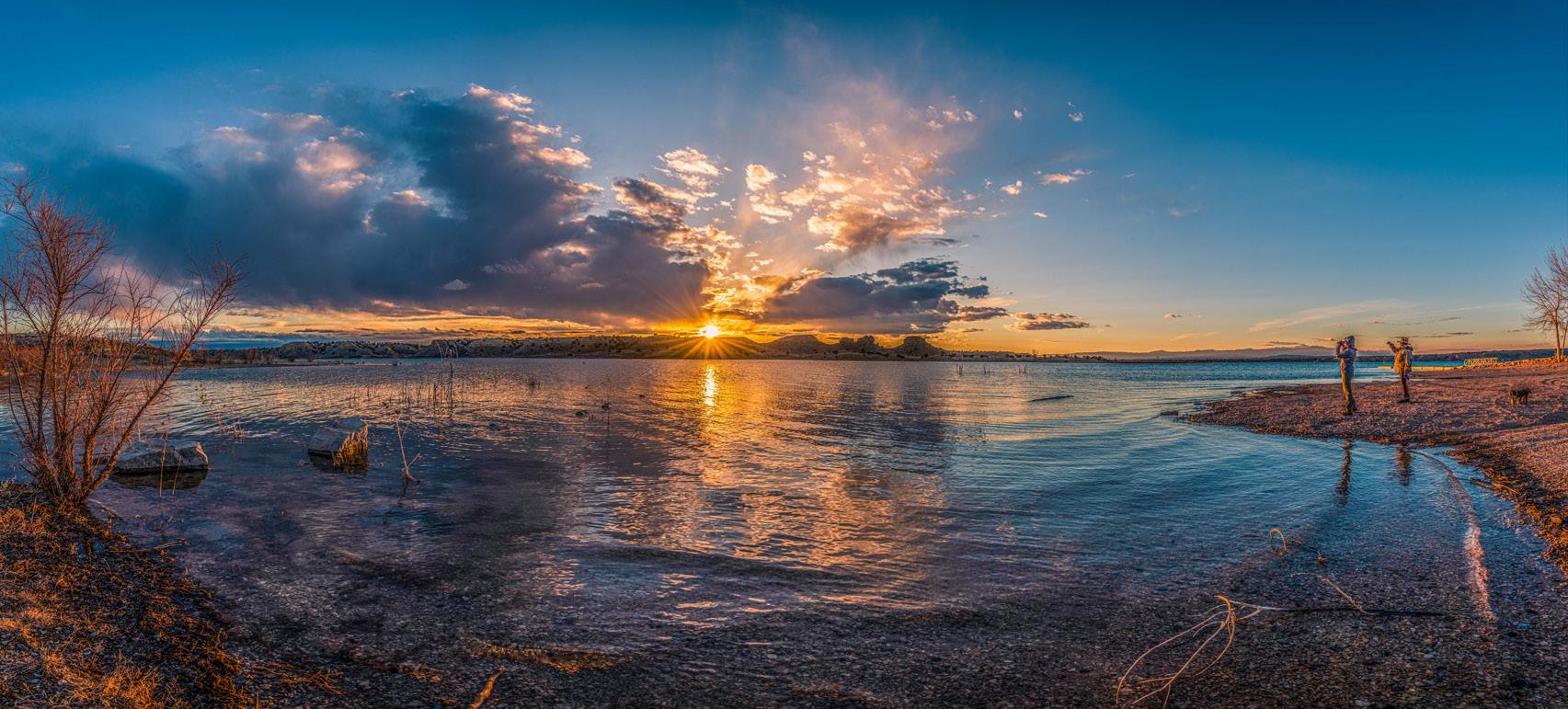
LAUNCHING POINTS FOR OUTDOOR EXPLORATION
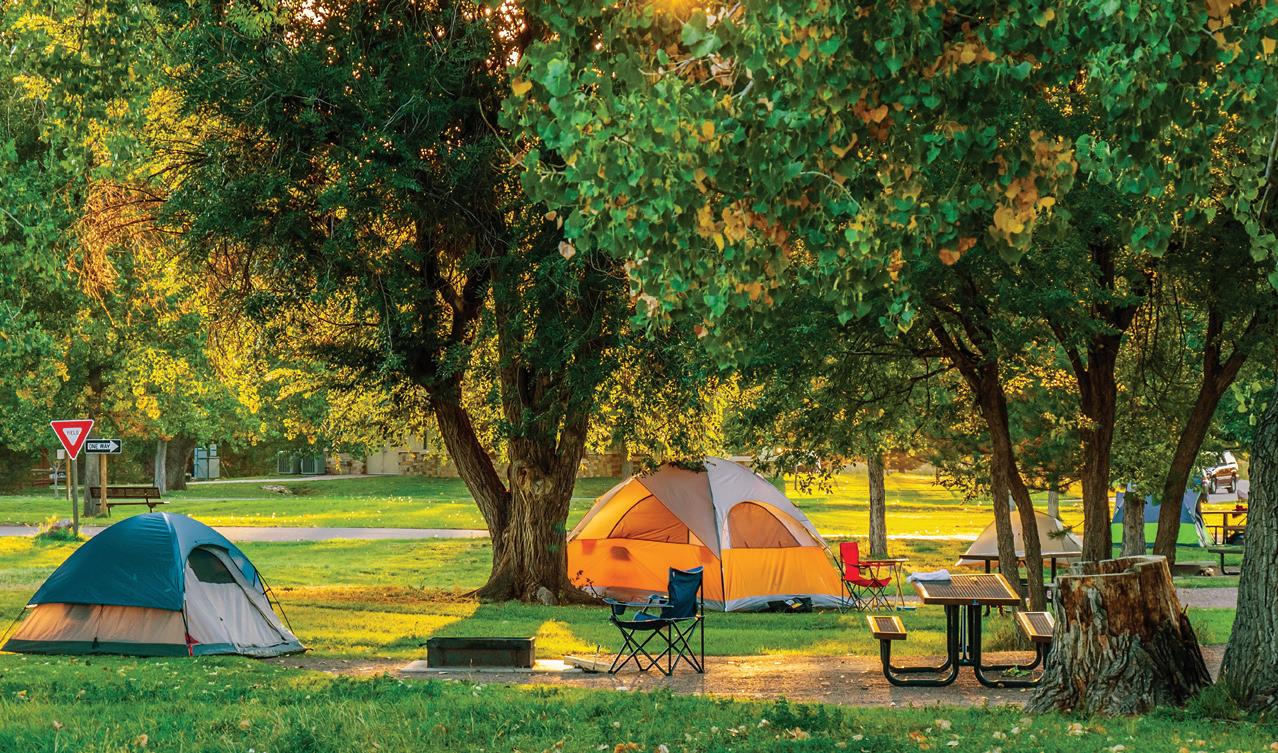
by DAN LEETH
TENT RV/SITES
ACTIVITIES
Biking, Boating, Hiking, Fishing
Cherry Creek State Park offers a pleasant springtime nature retreat at the edge of the Denver metro area
AS WE LONGTIME residents know, Colorado’s springtime weather is predictably unpredictable. Days of cold, wintery conditions can be followed by a week of sunny skies with temperatures balmy enough to make a desert dweller feel at home. When these first getaway-luring days hit, my wife and I like to dust off the camping gear and head out for a season-opening weekend of hot dogs and campfires.
For the first trip of the year, we like to stay close to home. That way, if anything goes wrong or gets forgotten (where are the tent stakes?), home lies a short drive away. Our favorite early season campground has been Cherry Creek State Park, which is located off Interstate 225 between Parker Road and Belleview Avenue. While camping reservations are required, we’ve found that it’s often possible to score a spur-ofthe-moment site in early springtime.
The campground sits a short stroll away from Cherry Creek Reservoir. Tent campers can pitch their shelters on tent pads or out on the grass. RV owners can choose back-in or pull-through sites with full hookups, perfect for flushing out water-system antifreeze and sanitizing fresh-
water holding tanks. The campground features flush-toilet restrooms, showers, laundry facilities and a visitor center where one can buy souvenir T-shirts and hoodies. If we discover something missing, there are numerous stores, restaurants and pizza delivery drivers nearby.
Towering cottonwood trees shade many of Cherry Creek’s sites, and deer can often be found wandering through the campground in the morning. Even with the city skyline rising across the water, camping here offers the feeling of being out in nature. Traffic noise from the interstate highway and Parker Road remains minimal, often muffled by the sound of rustling leaves.
There’s more to do at Cherry Creek than roast weenies. The park features a shooting range, a model airfield and a huge, off-leash dog park. Those with boats, kayaks or canoes can enjoy their sport on the 880-acre reservoir.
With 5 miles of shoreline, anglers will find an abundance of spots to fish for largemouth bass, channel catfish, black crappie, walleye, rainbow trout, bluegill and hybrid striped bass. For bird watchers, more than 150 species of resident and migratory birds have been spotted in the
park. If the day is warm enough, there’s a sandy swim beach for sunbathing or a goosebump-inducing dunk.
For us hikers, the park offers miles of trails, many of which are paved. From the campground, my wife and I like to walk the 6.7-mile loop around the lake. Done counter-clockwise, it begins with a stroll beneath the dam to the marina and on past a picnic area, whose concrete ramadas are shaped like whale’s tails. At the far end of the reservoir, the route winds through the lush woodlands before returning past a boat launch and the swim beach.
It’s the bicycling opportunities that many of us find most appealing about Cherry Creek State Park. The 40-milelong Cherry Creek Trail passes through the park. Energetic riders can pedal northwest through Denver to Confluence Park and beyond. Heading south, the trail goes all the way to Franktown with a short detour to Castlewood Canyon State Park. By following the Spillway Trail northeast from Cherry Creek, riders can connect onto the 71-mile Highline Canal Trail. For something a bit less lengthy, there’s the road loop around the reservoir, which draws many skinny-tire cyclists
the Denver Tech Center skyline.

training for events like Ride the Rockies. At day’s end, we like to walk down to the reservoir shoreline and watch the setting sun illuminate the distant skyline. Returning to our campsite, we’ll sit back and bask in the flickering flames of a campfire. With coals aglow, my wife will head to our food stash, intending to retrieve the ingredients she needs to make those scrumptious Girl Scout taste treats known as s’mores. Invariably, we’ll discover that one of us has somehow forgotten to pack the marshmallows, graham crackers and Hershey’s bars.
We may be close to home, but at this point, neither of us will be willing to drive back to get them.
Cherry Creek State Park features 136 campsites, 106 of which offer full hookups. Prices range from $28 per night for a basic, no hookup spot to $41 per night for an RV-worthy, full hookup site. A daily pass of $11 per vehicle is also required. Mandatory camping reservations may be made through Colorado Parks and Wildlife (cpw.state.co.us, 800-244-5613).

Questions on p 16-17
10 a. 303. The band’s name is 3OH!3.
11 True
12 False. He was nominated but didn’t win.
13 False. The songs’ identical titles are the only similarity.
14 True. For one day.
15 True
Trivia Photographs
Page 16
Funk band Earth, Wind & Fire has a Denver connection. Singer-songwriter John Denver named himself after the city. Page 17 The Lumineers perform live.
PHOTOGRAPH
BY
MICHELLE THEALL
ARAINBOW ARCS ACROSS the sky as an early-morning drizzle falls on a ranch near Creede. It is joined by a second, faint but distinct rainbow.
Professional photographer Michelle Theall witnessed this scene unfolding while housesitting at her friend’s ranch. Her first instinct was to reach for a camera. While she typically carries thousands of dollars of high-end camera equipment when she’s on official photo shoots, all she had handy to photodocument this unanticipated moment was an extremely basic point-and-shoot model – not ideal, but much better than nothing.
“I’ve always been told the best camera to own is the one you have with you,” Theall said.
She stood on the porch of her friend’s house, pointed the camera toward to barn and started shooting. The morning drizzle and accompanying rainbows lasted only 15 minutes before disappearing. However, that was all the time Theall needed to capture one of her all-time favorite shots.

IN EACH ISSUE, “Top Take” features a reader’s photograph of Colorado. Submit your best photos for the chance to be published in Colorado Life. Send images with detailed photo descriptions and your contact information to photos@coloradolifemag. com or visit coloradolifemag.com/contribute.
This photo was taken with a Canon PowerShot G9 camera equipped with a 7.4-44.4mm lens at 9mm, exposed at ISO 80, f/4 at 1/1000 of a second.


